Part III picture
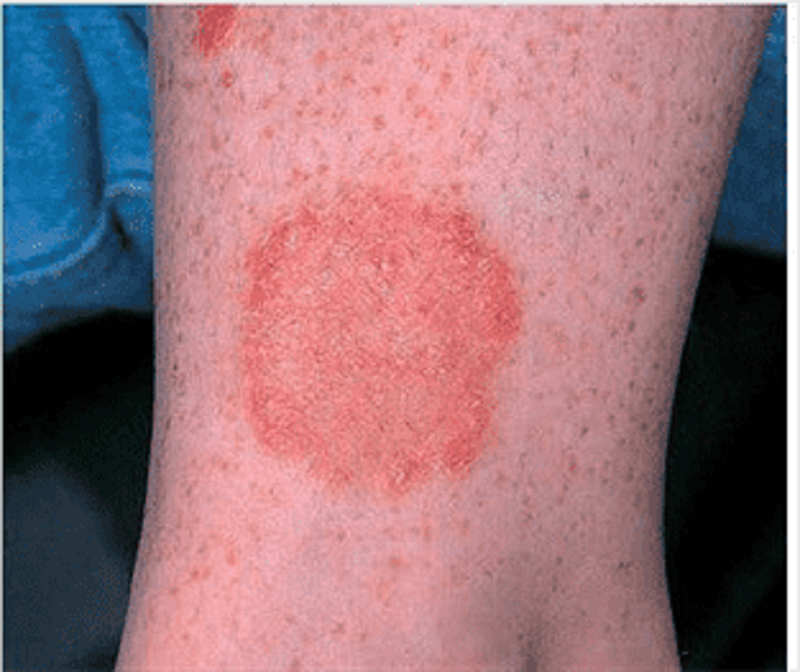
106) A 12-year-old boy notices a scaly, mildly pruritic rash on his arm (see image below). There is no associated fever, muscle pain, nausea, vomiting, diarrhea, or back pain. He recently started taking swimming classes. The rash is most likely to clear with which of the following therapies?
. Nafcillin
. Corticosteroids
. Retinoids
. Terbinafine
. Acyclovir
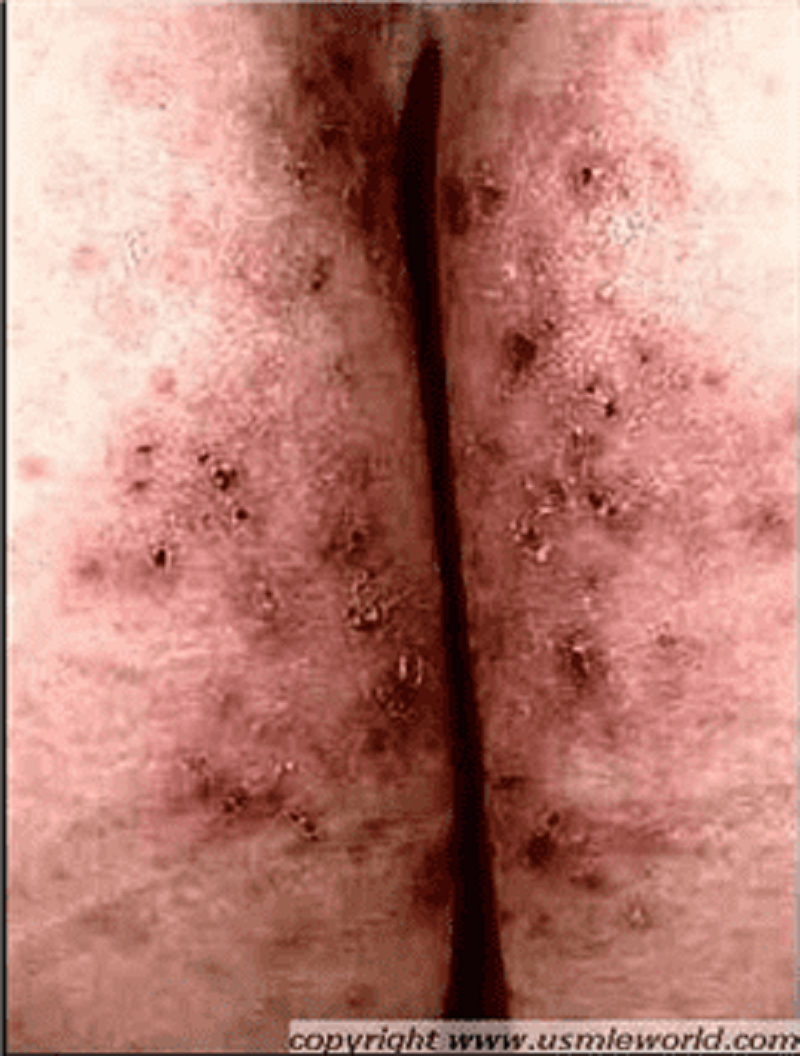
3) A 25-year-old male presents with skin lesions over his elbows, knees and neck. He complains of intense itching and burning sensation over these lesions for the past 10 days. He was advised to follow a gluten-free diet on his previous visit, but was not compliant. His vital signs are stable. On examination, there are flesh-colored to erythematous vesicles distributed over the extensor aspects of elbows, knees, posterior neck and shoulders. Some of these lesions are shown in the picture below. Which of the following is the drug of choice for his skin condition?
. High potency steroids
. Low dose acyclovir
. 1% lindane solution
. Azathioprine
. Dapsone

5) A 22-year-old male presents with a 6-month history of a red, nonpruritic rash over the trunk, scalp, elbows, and knees. These eruptions are more likely to occur during stressful periods and have occurred at sites of skin injury. The patient has tried topical hydrocortisone without benefit. On examination, sharply demarcated plaques are seen with a thick scale. Pitting of the fingernails is present. There is no evidence of synovitis. What is the best first step in the therapy of this patient’s skin disease?
. Photochemotherapy (PUVA)
. Oral methotrexate
. Topical calcipotriene
. Oral cyclosporine
. Topical fluticasone
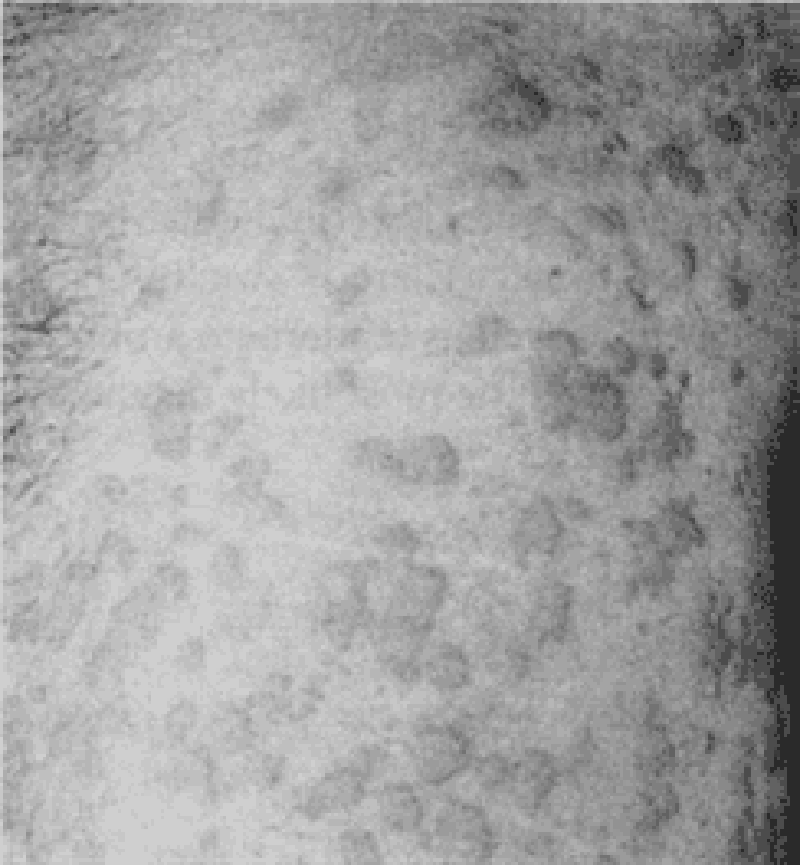
6) A 35-year-old woman develops an itchy rash over her back, legs, and trunk several hours after swimming in a lake. Erythematous, edematous papules and plaques are noted. The wheals vary in size. There are no mucosal lesions and no swelling of the lips. What is the best first step in management of her symptomatic rash?
. Subcutaneous epinephrine
. Intravenous glucocorticoids
. Oral antihistamines (H1 blockers)
. Aspirin
. Oral doxycycline

10) A 50-year-old male comes to the office due to an ulcer in his right foot. He has type 2 diabetes, for which he takes glyburide. Laboratory investigations reveal an HbA1c of 9%, and random blood sugar of 180 mg/dL. X-ray of the leg/foot is normal. A picture of the foot ulcer is shown below. Which of the following is the most appropriate management of this patient's foot ulcer?
. Start aspirin and atorvastatin
. Perform thorough debridement of the wound
. Prescribe tight-fitting shoes
. Prescribe oral antibiotics and follow-up as an outpatient
. Amputation

25) A 25-year-old female comes to the office for a follow-up visit. She was just diagnosed with type 1 diabetes mellitus a few days ago, when she presented at the emergency department with ketoacidosis. After successful management of her diabetic ketoacidosis (DKA), she was sent home on an insulin regimen with the following dosage: Before breakfast 10 units of NPH and 10 units of regular insulin, Before supper 10 units of NPH and 4 units of regular insulin. During this office visit, she shows the record of her fingerstick readings at home. For the last 2 days, her blood glucose levels were (see in pic). What is the most likely explanation for her 7:00 am blood glucose level?
. Spikes of growth hormone release
. Epinephrine, norepinephrine, & glucagon release
. Waning of insulin levels
. Destruction of glucagon-secreting cells
. Decrease Insulin-secretor
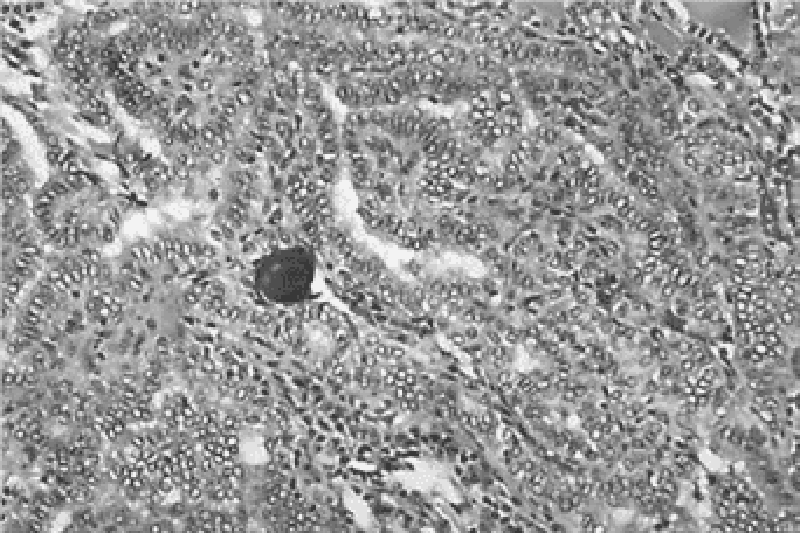
34) A 19-year-old G1P0 woman at 32 weeks gestation presents for scheduled prenatal appointment. The pregnancy has been uncomplicated to date. However, she mentions that she recently noticed a hard lump on her neck. She denies pain or difficulty swallowing, speaking, or breathing. Physical examination reveals a firm, nontender, immobile, solitary nodule on the left hemithyroid. Ultrasound reveals a solid 2-cm mass. There is no cervical lymphadenopathy. Thyroid function tests reveal a thyroid-stimulating hormone level of 1.2 μU/mL and free thyroxine level of 0.9 ng/dL. Results of fine-needle aspiration biopsy are shown in the image. Which of the following is the best next step in management?
Left hemithyroidectomy
Monitor until after delivery
Radioablation therapy
Start methimazole
Start propylthiouracil
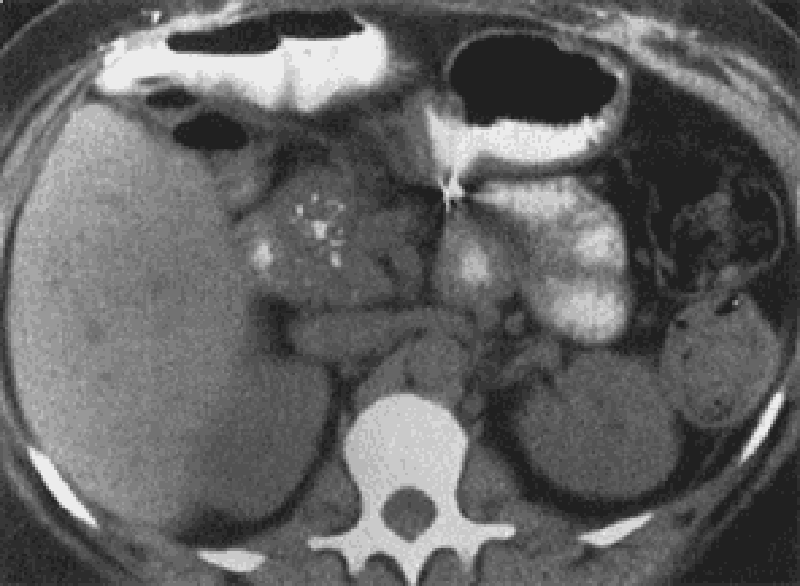
84) A 76-year-old man who has had multiple episodes of pancreatitis presents to his physician’s office with mild epigastric pain and 9.1-kg (20.0-lb) weight loss over the past 6 months. The patient also describes daily foul-smelling stools that “float” in the toilet bowl. The physician pulls up his electronic medical record and finds that the patient presented to the emergency department last week for the same symptoms. During that visit he had a CT of the abdomen (see image). Which of the following is the most appropriate treatment?
Endoscopic retrograde cholangiopancreatography
Pancreatic enzyme replacement
Pancreaticogastrostomy
Surgical resection of pancreas
Whipple procedure
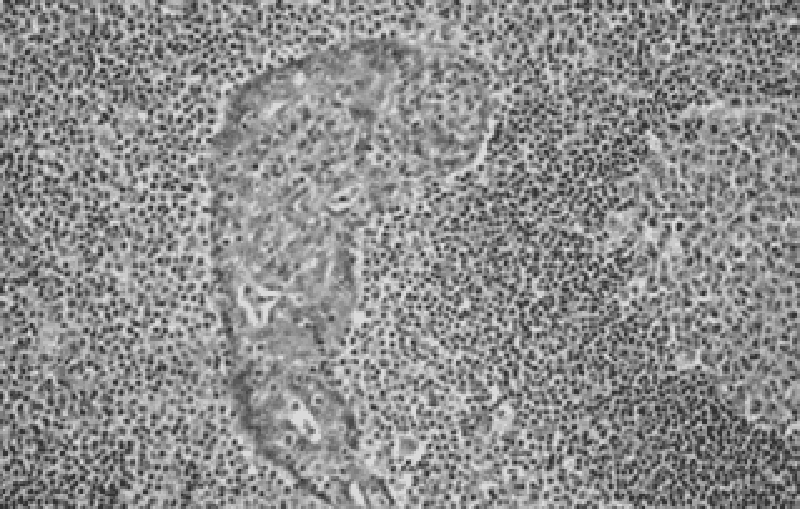
92) A 54-year-old man presents to his primary care provider with the complaint of upper abdominal fullness and pain. He states that he has lost 2.3-4.6 kg (5-10 lb), but denies other symptoms. Physical examination reveals a firm mass in the epigastric area. Ultrasonography reveals a mass in the gastric antrum. A salivary gland biopsy reveals the pathology shown in the image. Which of the following therapies is expected to be part of his treatment plan?
Antibiotic therapy
Bone marrow transplantation
Gene therapy
Liver transplantation
Multiagent chemotherapy
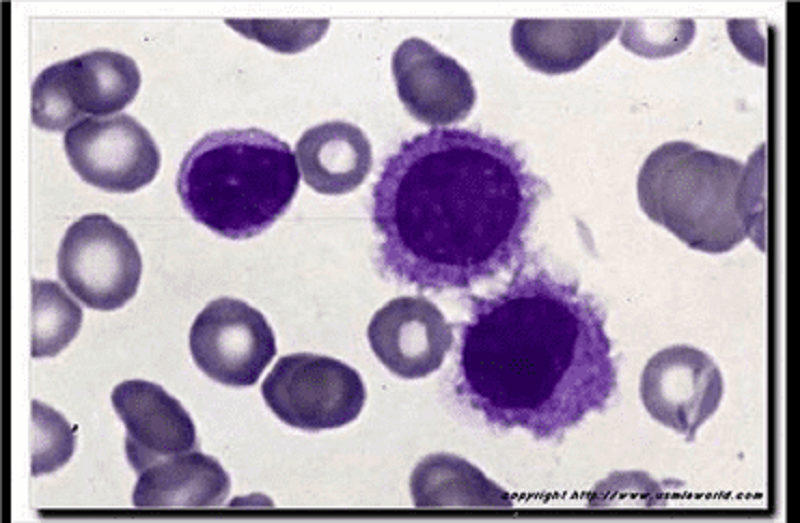
9) A 55-year-old male comes to the physician's office because of fatigue. He denies any other symptoms. His vital signs are stable. Examination shows pallor, massive splenomegaly, and mild hepatomegaly. CBC reveals pancytopenia with striking monocytopenia. His peripheral blood smear is shown below. Bone marrow biopsy shows a dry tap. What is the most appropriate treatment for this patient's condition?
. Bone marrow transplantation
. Cladribine
. Cyclophosphamide
. CHOP regimen
. Chlorambucil and prednisone
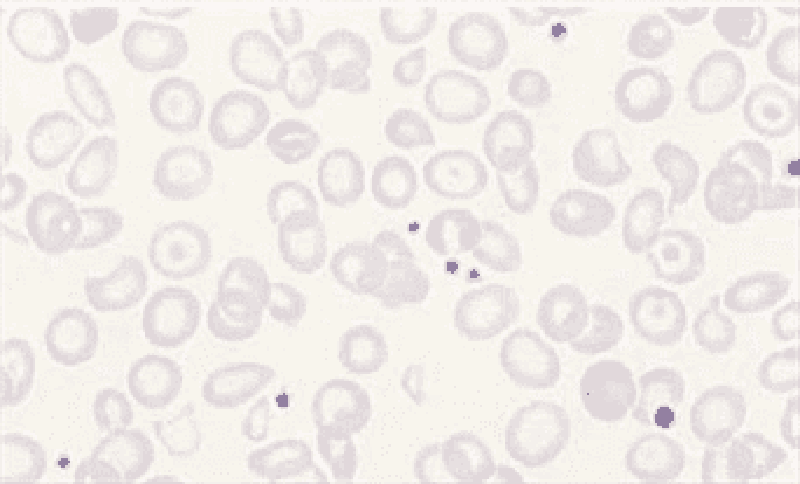
12) A 32-year-old Italian-American man presents to your office for a routine check-up. He works as a business executive and admits to being under a lot of stress recently. He drinks alcohol occasionally and smokes one pack of cigarettes per day. Laboratory analyses reveal: Hemoglobin 10.1 mg/dl, RBC count 4.0 x 10^12/L, MCV 70fl, WBC count 5,500/mm3, Platelets 170,000/mm3, Serum calcium 10.1 mg/dl, Serum potassium 4.5 meq/L, Serum sodium 135 meq/L. Serial fecal occult blood tests are negative. A peripheral blood smear reveals the following: Which of the following is the best treatment for this patient?
. Iron
. Folic acid
. Cobalamin
. Reassurance
. Erythropoietin
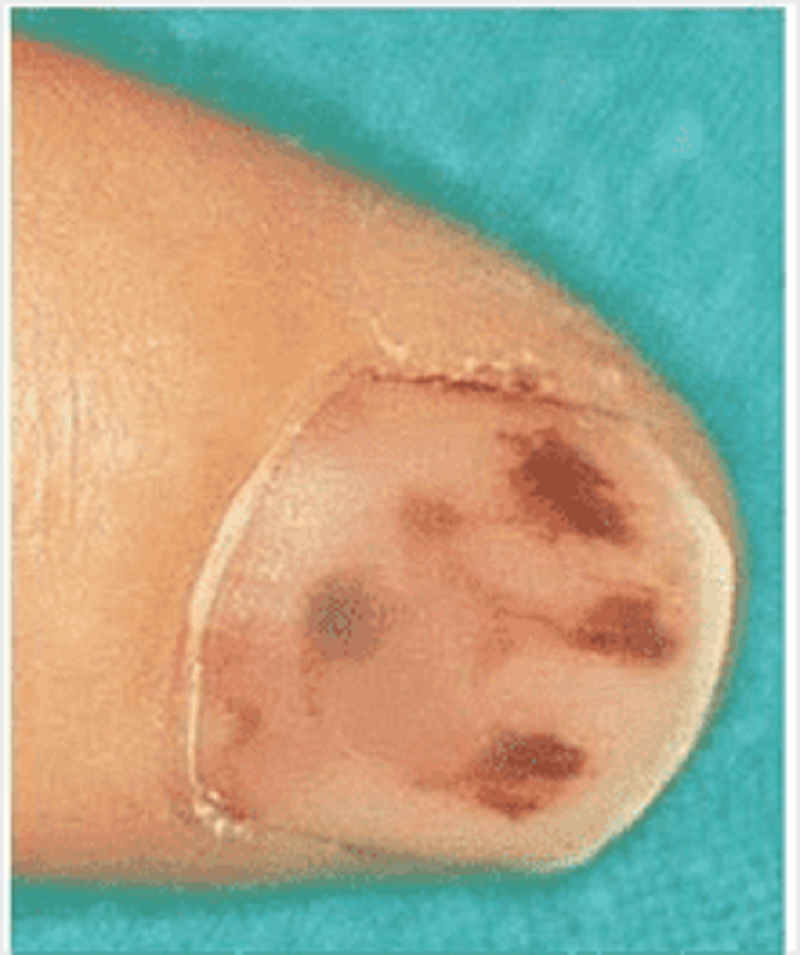
48) A 27-year-old man presents with fever, malaise, anorexia, and fatigue for the last three days. He denies cough, chest pain, arthralgias, and diarrhea. He has history of rheumatic heart disease and recently underwent a dental cleaning. His temperature is 38.5°C (101.3°F), pulse is 90/min, respirations are 18/min, and blood pressure is 135/76 mm Hg. Examination of his fingernail is shown below. Cardiovascular examination reveals an early diastolic murmur in the mitral area. The chest x-ray is negative. Urinalysis shows microscopic hematuria. What is the most appropriate next step in the management of this patient?
. Start antibiotics immediately and then obtain blood cultures
. Start antibiotics after drawing blood for culture
. Do transesophageal echocardiography
. Do transthoracic echocardiography
. Give aspirin and start his penicillin prophvlaxis

53) A 40-year -old man who underwent a renal transplant six months ago comes to the clinic with fever, chills, and a productive cough. His temperature is 39.4°C (103°F), pulse is 110/min, respirations are 22/min, and blood pressure is 110/65 mmHg. Chest x-ray shows a right lower lobe nodule with a cavity. Sputum gram stain is shown below. What is the most appropriate treatment of this patient's condition?
. Penicillin
. Trimethoprim-sulfamethoxazole
. Vancomycin
. Gentamycin
. Metronidazole
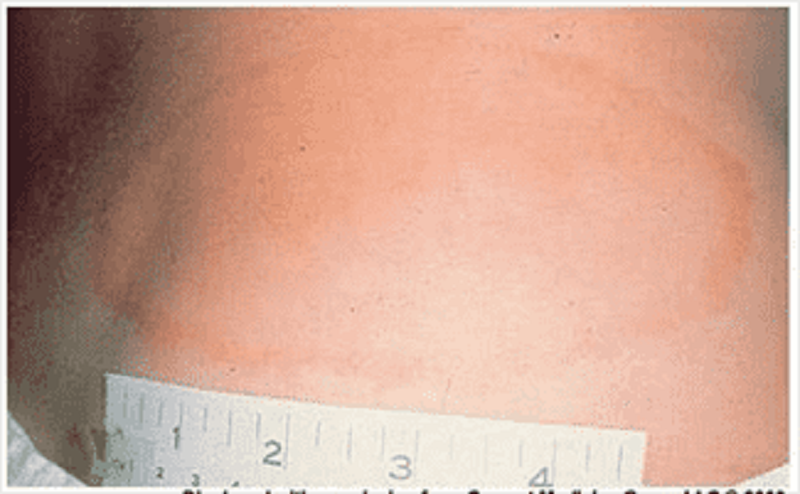
55) A 22-year-old female presents to the office with a three-day history of rash, fever, and malaise. There is no burning or itching associated with the rash. Two weeks ago, she had been camping in northern Massachusetts, and noted a tick bite after walking through the woods. She is twelve weeks pregnant. The rash is shown below. The examination is otherwise unremarkable. What is the most appropriate treatment for this patient?
. Doxycycline
. Amoxicillin
. Azithromycin
. Ceftriaxone
. Penicillin G

77) A 68-year-old male presents to the emergency room with cough. Chest x-ray is clear of infiltrates but reveals a right upper lobe lung lesion incidentally. A chest CT scan with IV contrast is performed in the emergency department and reveals a 1 cm x 2cm round lesion in the right upper lobe. The patient is admitted to the hospital, and by day 3 of his hospitalization, he has developed acute renal failure. The patient's past medical history is significant for hypertension, hyperlipidemia, diabetes and coronary artery disease. His medications include aspirin, hydrochlorothiazide, clopidogrel, metoprolol, atorvastatin and lisinopril, all of which he has been taking for several years. He has no known drug allergies. He is a former smoker and does not use alcohol or drugs. His baseline blood pressure is 140/90 mm Hg and has remained in the 140s/90s throughout this admission. Physical examination is otherwise unremarkable. The patient's laboratory values from the time of admission to present are given below. Over the course of the next week, the patient's renal function returns to normal. Which of the following would most likely have prevented his renal failure?
. Prednisone
. Furosemide
. Stopping clopidogrel
. Intravenous hydration
. 100% oxygen mask

86) A healthy 54-year-old man comes to the physician for a routine health maintenance examination. He has no complaints, but he is requesting for a CT scan of the abdomen. His father died at the age of 60 due to the sudden rupture of an undiagnosed abdominal aortic aneurysm. He has a history of hypertension and gouty arthritis. His social history is not significant. His vital signs are stable. Physical examination shows no abnormalities. ACT scan of the abdomen is shown below. Which of the following is the most appropriate next step in management?
. Reassurance
. Surgery
. CT guided biopsy
. Antibiotics
. Repeat CT scan in 3 months
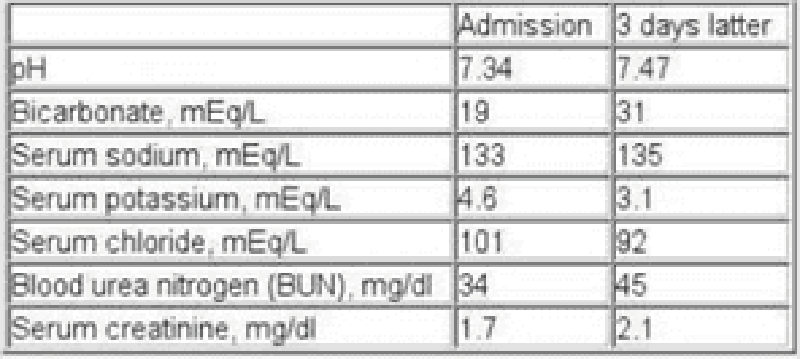
107) A 58-year-old alcoholic is admitted with diagnosis of decompensated liver cirrhosis. The lab panel is shown below on the day of admission and 3 days later. Which of the following best explains the acid-base status change in this patient?
. Acute renal failure
. Bowel ischemia
. Loop diuretic therapy
. Opioid medication use
. Right lower lobe atelectasis
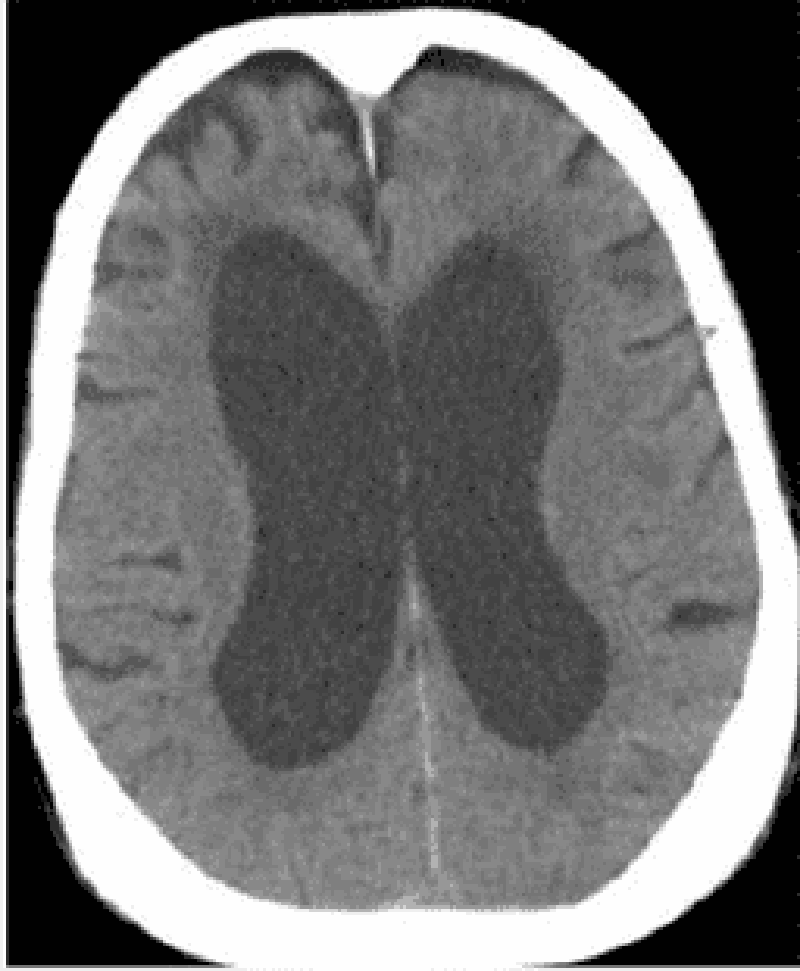
112) A 79-year-old woman presents to her primary care physician complaining of memory loss. She reports increasing difficulty balancing her check book and remembering the names of new acquaintances over the last several months. Her only other complaint is occasional urinary incontinence, which she attributes to old age. She denies headache, vision changes, rash, nausea, or vomiting. Her past medical history is significant for hypertension controlled with felodipine. On exam her vital signs are within normal limits. The heart and lung exams are also unremarkable. The cranial nerves are intact, fundoscopic exam is normal, and no tremor is observed. Her gait is slow and shuffling, there is no dysmetria, and her Folstein mini-mental status score is 24/30. CT scan of her brain is shown below. Which of the following interventions is most likely to relieve her symptoms?
. Ventriculoperitoneal shunt
. Hematoma evacuation
. Levodopa/carbidopa
. Vitamin B12 replacement
. High-dose penicillin
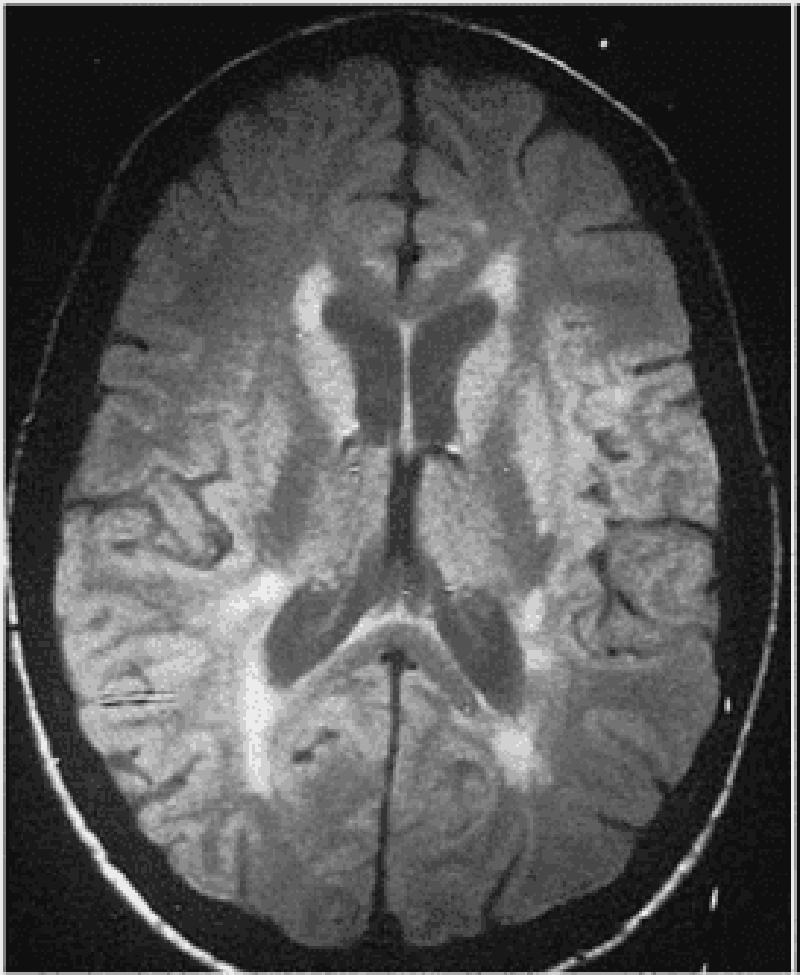
122) A 38-year-old female presents with one week of "shakiness" in her right arm, right leg weakness and unsteady gait. An MRI of her brain is shown below. Which of the following is the best treatment for this patient?
. Aspirin and simvastatin
. Glatiramer acetate
. Argatroban
. Tissue plasminogen activator
. Broad-spectrum antibiotics

143) A 21-year-old man presents to the ED with a red eye. The patient complains of rhinorrhea and a nonproductive cough but has no eye pain or discharge. He also has no associated ecchymosis, bony tenderness of the orbit, or pain on extraocular eye movement. His vision is normal, extraocular movements are intact, and intraocular pressure (IOP) is 12. A picture of his eye is shown below. What is the most appropriate management of this condition?
. Call ophthalmology immediately
. Administer 1% atropine
. Elevate patient’s head
. Administer ophthalmic timolol
. Reassurance only
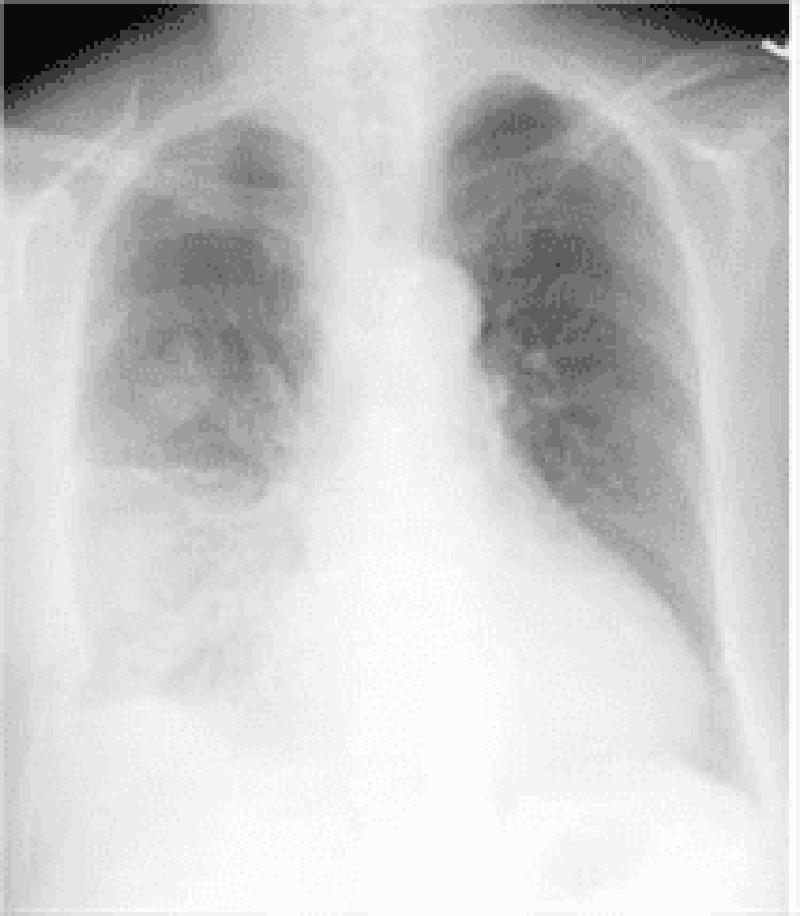
150) A 65-year-old white male who has a history of chronic obstructive pulmonary disease, congestive heart failure, and coronary artery disease presented with a three-day history of worsening shortness of breath, cough with yellowish expectoration, and fever. He is not on steroids and does not use oxygen at home. He takes ipratropium, albuterol, aspirin, digoxin, furosemide, metoprolol, and lisinopril. He lives at home with his wife. His temperature is 39.4°C (103°F), blood pressure is 110/70 mmHg, pulse is 110/min, and respirations are 24/min. He is saturating 88% on room air. He was started on 3-liters of oxygen to keep the saturations above 92%. The chest x-ray of the patient is shown below. What is the most appropriate next step in the management of this patient?
. Admit the patient and give ampicillin
. Outpatient trimethoprim-sulfamethoxazole
. Admit the patient and start levofloxacin
. Admit the patient and start ciprofloxacin
. Admit the patient and start vancomycin
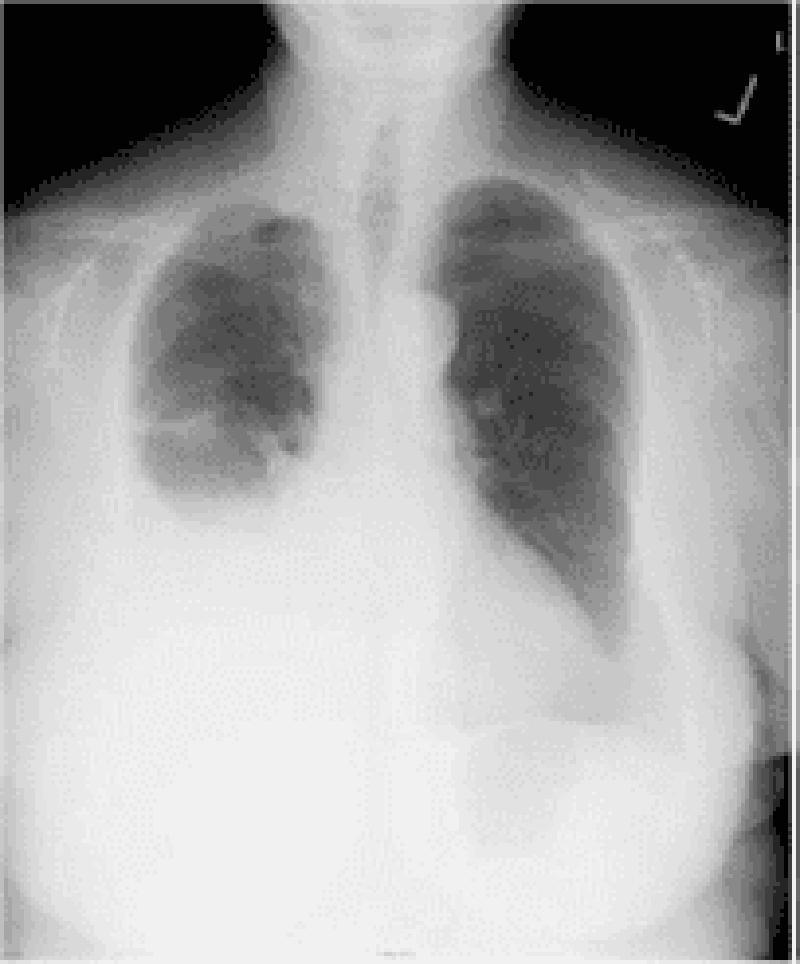
174) A 60-year-old Caucasian female comes to the physician because of progressive shortness of breath for the past month. She has had a 13.6 kg (30 lb) weight loss during this period. She has a history of hypertension and hypothyroidism and takes metoprolol and levothyroxine. She has smoked two packs of cigarettes daily for 35 years. Her temperature is 36.7°C (98°F), blood pressure is 130/70 mmHg, pulse is 80/min, and respirations are 20/min. On examination, decreased breath sounds and dullness to percussion are noted on the right, middle and lower lobes of the lung. Her chest x-ray is shown below. Which of the following is the most appropriate next step in the management?
. Bronchoscopy
. Mediastinoscopy
. Thoracentesis
. Video-assisted thoracoscopy
. Open pleural biopsy
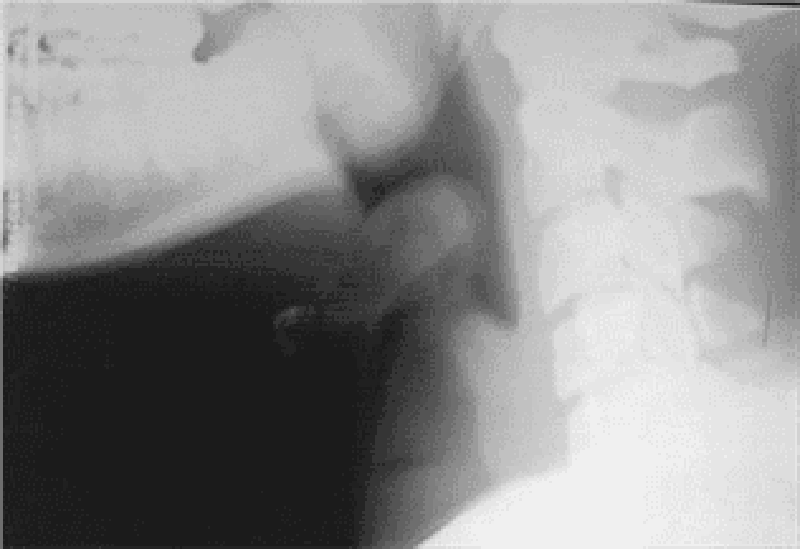
178) A 3-year-old boy presents to the emergency department with a fever and difficulty breathing. He is the product of a normal pregnancy and has been healthy since birth. His immunizations are up to date. This morning he appeared to be in his usual state of health and was dropped off at day care by his father. Later on, his teacher noticed that he had suddenly become fussy and flushed and could not be consoled with toys, rocking, or hearing a story. He also felt warm to the touch and was drooling more than usual. When she took his temperature, it was 39°C (102.2°F). His parents were contacted immediately, and the patient was brought to the emergency department. He appears toxic and anxious, and has loud labored breathing. He is sitting upright, bracing himself on his arms, with his neck hyperextended and mouth open. His temperature is 40°C (104°F), respiratory rate is 50/min, pulse is 140/min, blood pressure is 102/62 mm Hg, and oxygen saturation is 100% on room air. Lateral x-ray of the neck is shown in the image. Laryngoscopy reveals a large cherryred epiglottitis. What is the most appropriate next step in management?
Antibiotic therapy
Corticosteroids
Nasotracheal intubation
Observation
Tracheostomy

3) A 25-year-old G2, PI at 28 weeks gestation is brought to the emergency department by her boyfriend, who found her lying on her bed in a pool of blood. She is very drowsy, but denies any pain or uterine contraction. Her temperature is 38°C (100.4°F) and respirations are 18/min. Physical examination is suggestive of a transverse lie. Inspection of the perineum reveals gross blood and active bleeding per vagina. Which of the following set of parameters would most likely be seen in this patient?
. Set A
. set B
. Set C
. set D
. set E
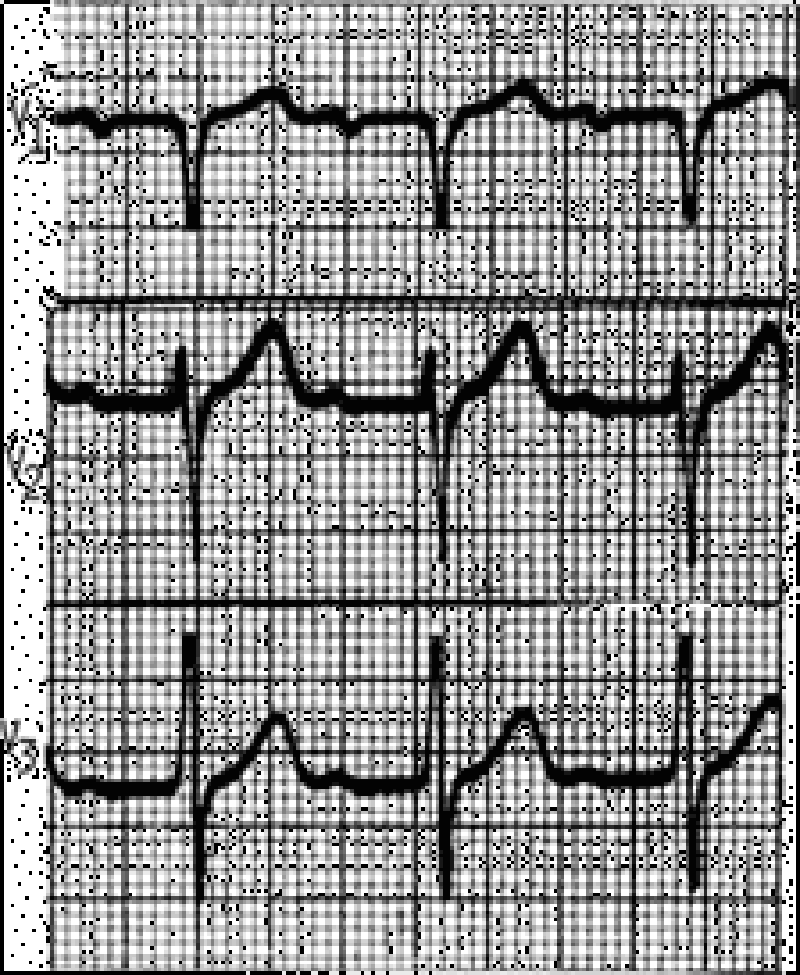
10) An 18-year-old male complains of fever and transient pain in both knees and elbows. The right knee was red and swollen for 1 day during the week prior to presentation. On physical examination, the patient has a low-grade fever. He has a III/VI, high pitched, apical systolic murmur with radiation to the axilla, as well as a soft, mid-diastolic murmur heard at the base. A tender nodule is palpated over an extensor tendon of the hand. There are pink erythematous lesions over the abdomen, some with central clearing. The following laboratory values are obtained: Hct: 42, WBC: 12,000/μL with 80% polymorphonuclear leukocytes, 20% lymphocytes, ESR: 60 mm/h. The patient’s ECG is shown below. Which of the following tests is most critical to diagnosis?
. Blood cultures
. Antistreptolysin O antibody
. Echocardiogram
. Antinuclear antibodies
. Creatine kinase
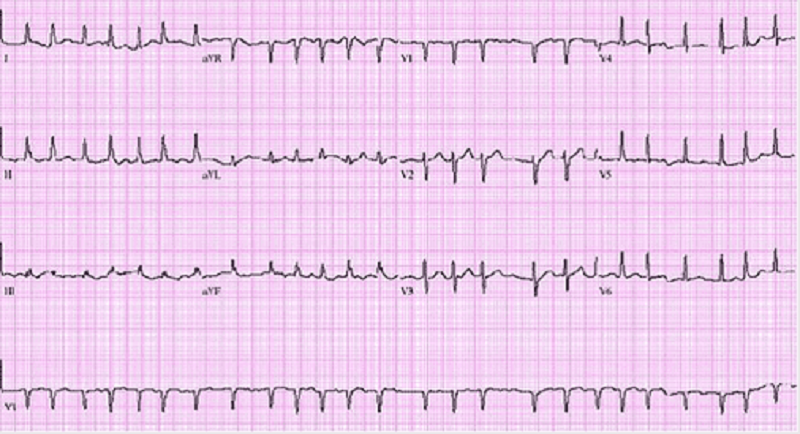
16) A 46-year-old man comes to the ER because of weakness and chest tightness. He has had these symptoms for the past one hour. He denies any past medical history. He does not smoke or drink alcohol. His father had a myocardial infarction at 68 years of age and his mother has myasthenia gravis. His EKG is shown on the slide below. The patient should be evaluated for which of the following?
. Cushing syndrome
. Hyperthyroidism
. Aortic dissection
. High-frequency deafness
. High-range proteinuria

20) A 77-year-old woman comes to the emergency department because of feeling “light-headed and dizzy.” Except for the irregular pulse, her physical examination is normal. What is the rhythm in the lead tracing shown in Fig.?
First-degree heart block
Second-degree heart block
Third-degree heart block
Premature ventricular beats
Premature atrial beats

21) The ECG shown in Fig. Was obtained during the initial stages of an acute MI. The patient had just received thrombolytic therapy. What is the rhythm?
Atrial fibrillation
Atrial flutter
Second-degree heart block
Wenckebach phenomenon
Nonsustained ventricular tachycardia
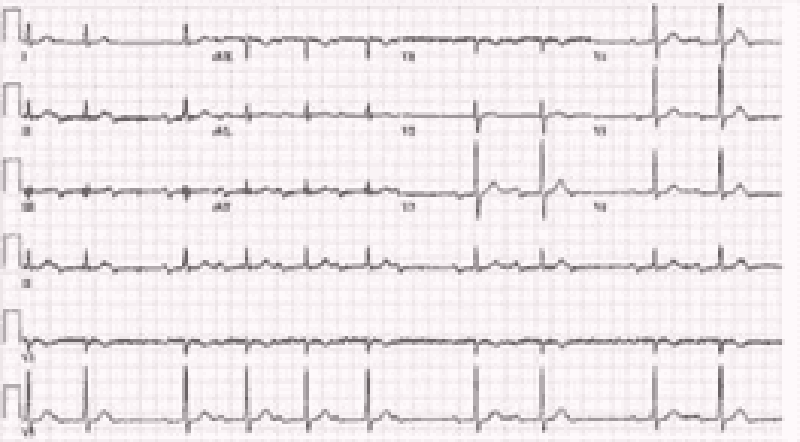
25) A 42-year -old male with a past medical history of bladder cancer and recurrent hematuria presents to the emergency room after "passing out" when he got out of bed this morning. The patient says that he was standing up to urinate shortly after waking when he began feeling dizzy. Fortunately he was able to return to his bed before losing consciousness for 7-10 minutes. His EKG at the time of admission is shown below. Which of the following most likely accounts for the observed EKG changes?
. Ventricular preexcitation
. Impaired SA node automaticity
. Impaired AV node conduction
. Atrial reentry
. His bundle branch block
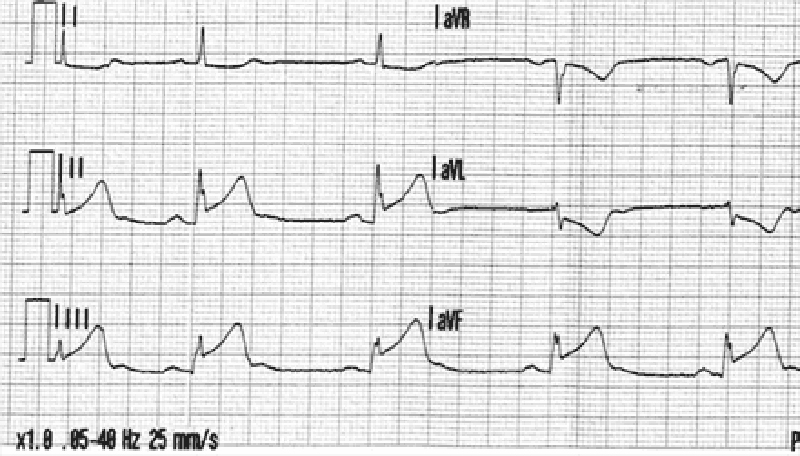
29) A 61-year-old woman was on her way to the grocery store when she started feeling chest pressure in the center of her chest. She became diaphoretic and felt short of breath. On arrival to the ED by EMS, her BP is 130/70 mmHg, HR is 76 beats per minute, and oxygen saturation is 98% on room air. The nurse gives her an aspirin and an ECG is performed as seen below. Which of the following best describes the location of this patient’s myocardial infarction (MI)?
. Anteroseptal
. Anterior
. Lateral
. Inferior
. Posterior
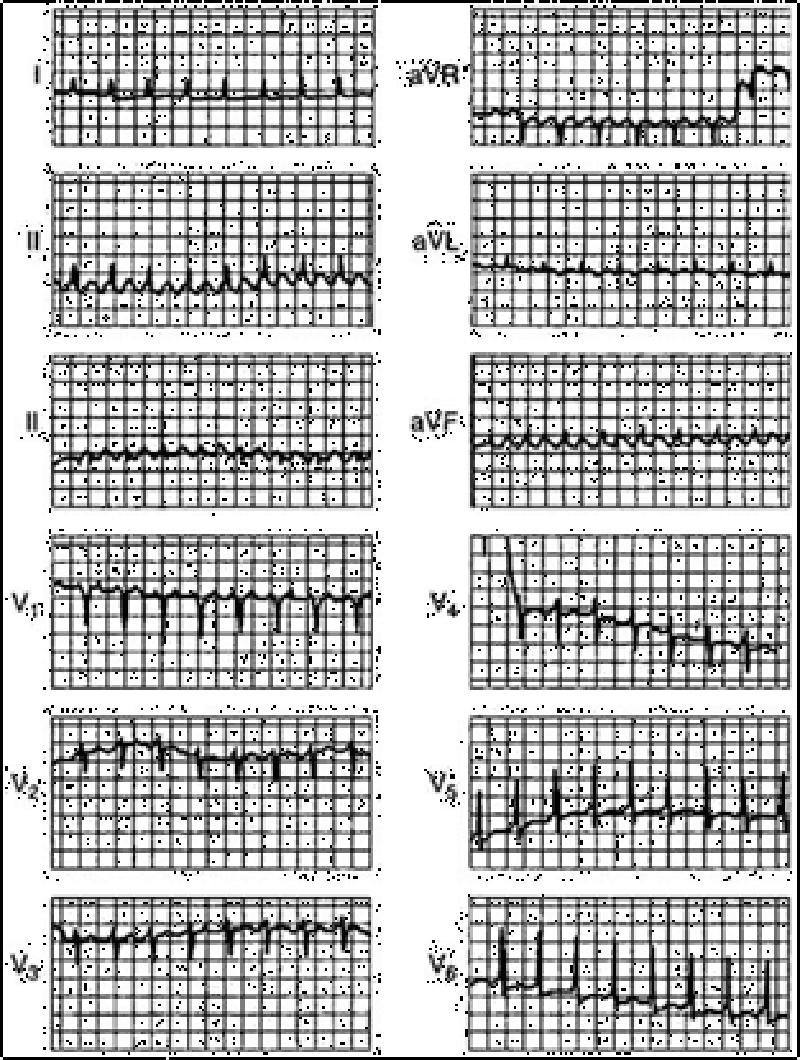
38) A 70-year-old man has dyspnea, orthopnea, and paroxysmal nocturnal dyspnea. He has generalized cardiomegaly and pulmonary and systemic venous hypertension. The ECG is shown in Fig.What is the cardiac rhythm?
Ectopic atrial tachycardia
Atrial flutter with 2:1 AV conduction
Sinus tachycardia
Supraventricular tachycardia
Atrial fibrillation with rapid ventricular response
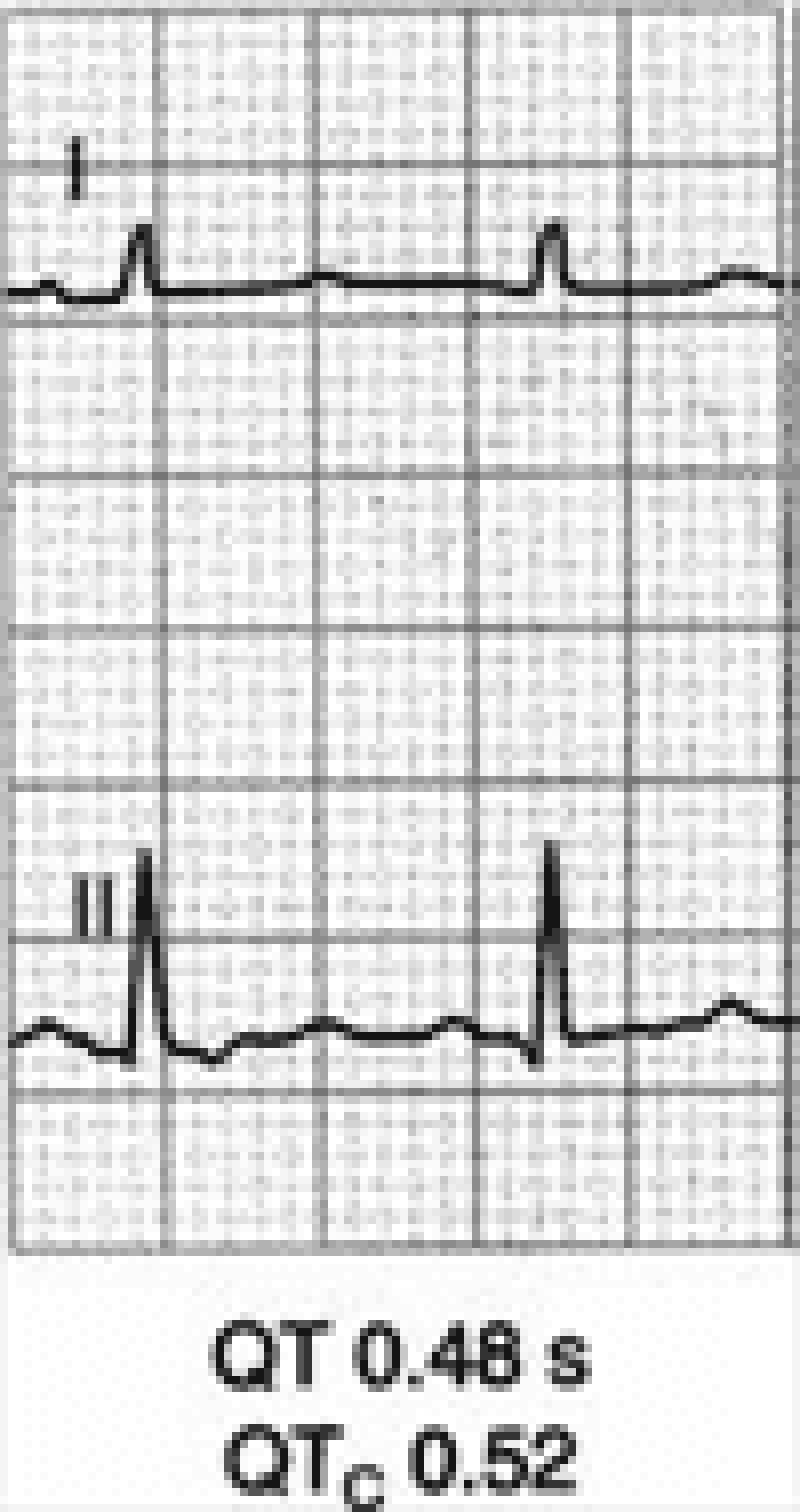
42) You are called by a surgical colleague to evaluate a 54-year-old woman with ECG abnormalities one day after a subtotal thyroidectomy for a toxic multinodular goiter. Her only medication is fentanyl for postoperative pain control. The patient denies any history of syncope, and has no family history of sudden cardiac death. Physical examination is unremarkable except for a clean postoperative incision at the base of the neck. Her ECG is reproduced below. What is the best next step in evaluation and management of this patient?
Administration of intravenous magnesium sulfate
Measurement of serum ionized calcium
Stat noncontrast CT scan of the brain
Formal auditory testing
Reassure the patient that her ECG is normal for a woman her age

45) A 58-year-old man is brought to the ED for a syncopal episode at dinner. His wife states that he was well until she found him suddenly slumping in the chair and losing consciousness for a minute. The patient recalls having some chest discomfort and shortness of breath prior to the episode. His rhythm strip, obtained by EMS, is shown below. Which of the following best describes these findings?
Mobitz type I
Mobitz type II
First-degree atrioventricular (AV) block
Atrial flutter with premature ventricular contractions (PVCs)
Sinus bradycardia
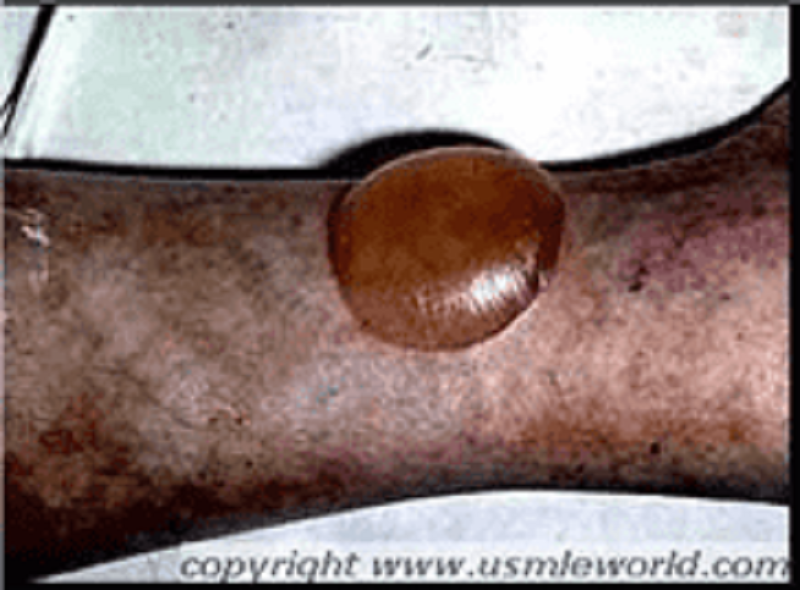
49) A 65-year-old male comes to the office on a hot summer afternoon. He complains of blisters and intense itching all over his body for the past 2 days. He has been having "itchy red swelling all over" for the past 2 months, which he thinks is due to the summer heat. His pulse is 82/min, blood pressure is 140/80 mmHg, respirations are 14/min, and temperature is 36.8°C (98.4°F). On examination, lesions are seen on both normal and erythematous skin over flexural areas of the groin, axilla and legs. An image of one of these lesions is shown below. Which of the following is most likely seen with this patient's condition?
. IgG and C3 deposits at the dermal-epidermal junction
. IgG deposits intercellularly in the epidermis
. IgG deposits in a linear band at the dermal-epidermal junction
. C3 at the basement membrane zone
. Intradermal edema with leukocyte infiltration
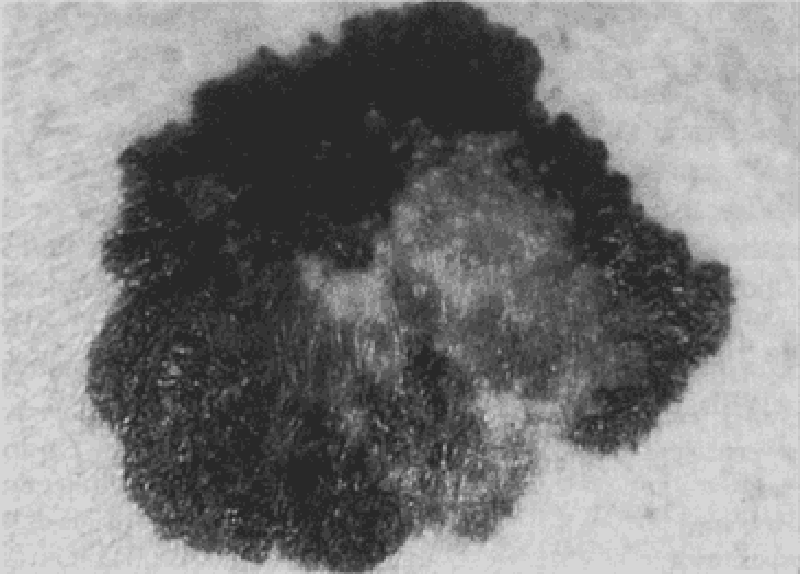
52) A 25-year-old female with blonde hair and fair complexion complains of a mole on her upper back. The lesion is 8 mm in diameter, darkly pigmented, and asymmetric, with an irregular border (see illustration below). Which of the following is the best next step in management?
. Tell the patient to avoid sunlight
. Follow the lesion for any evidence of growth
. Obtain metastatic workup
. Obtain full-thickness excisional biopsy
. Obtain shave biopsy
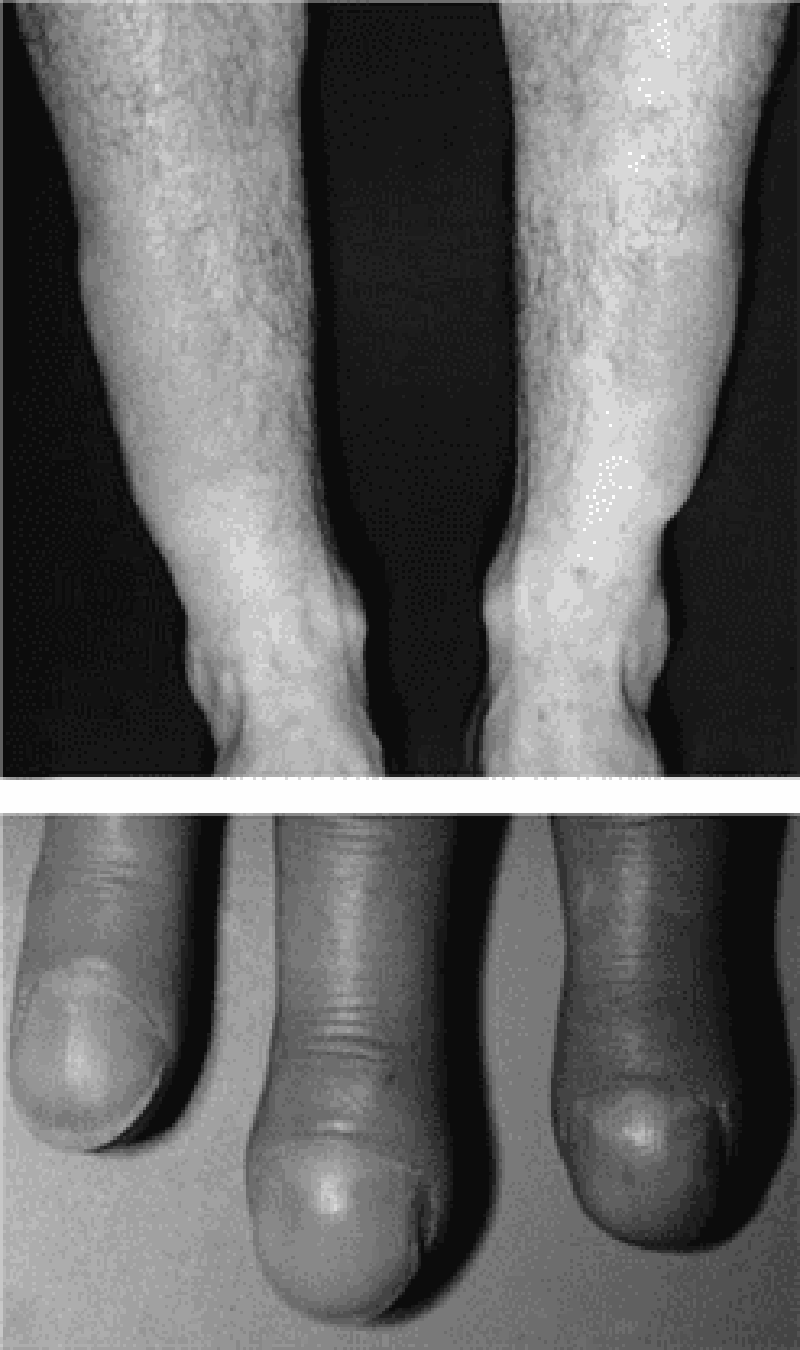
78) A 30-year-old female complains of palpitations, fatigue, and insomnia. On physical examination, her extremities are warm and she is tachycardic. There is diffuse thyroid gland enlargement and proptosis. There is thickening of the skin in the pretibial area. Mild clubbing of digits is present. Which of the following laboratory values would you expect in this patient?
. Increased free thyroxine (free T4), increased TSH
. Increased free thyroxine, decreased TSH
. Increased free thyroxine, normal TSH
. Normal free thyroxine, elevated triiodothyronine (T3), normal TSH
. Normal free thyroxine, decreased TSH
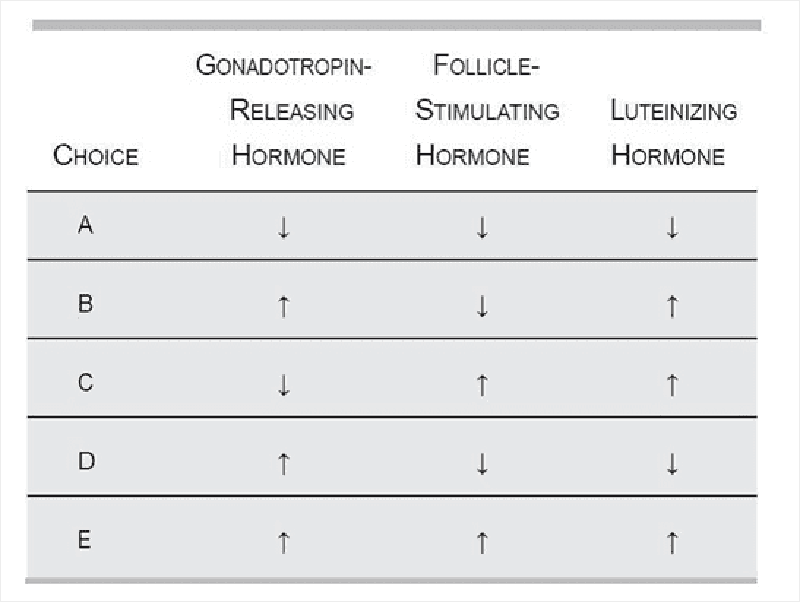
80) A 17-year-old girl has never had a menstrual period. On physical examination, she has minimal breast development and no axillary or pubic hair. She is color blind and has had a diminished sense of smell since birth. Laboratory evaluation would most likely reveal which of the following?
A
B
C
D
E

89) A 14-year-old boy presents at the pediatric clinic for a routine check-up. The patient had developed end-stage renal disease over the previous 2 years, and was successfully treated with a renal transplant 6 months prior. Since his operation, he has developed purple striae on his back and arms, central obesity, and an increasingly round face. During the subsequent blood analysis, which of the following results would be most likely?
A
B
C
D
E
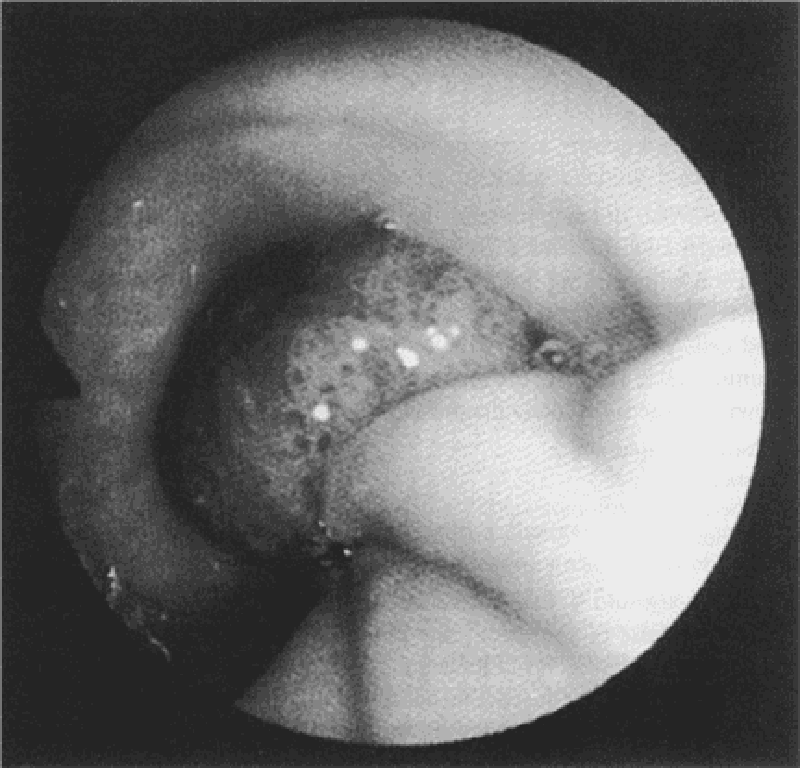
133) A 58-year-old white man complains of intermittent rectal bleeding and, at the time of colonoscopy, is found to have internal hemorrhoids and the lesion shown at the splenic flexure. Pathology shows tubulovillous changes. Repeat colonoscopy should be recommended at what interval?
. In 1 to 2 months
. In 1 year
. In 3 years
. In 10 years
. Repeat colonoscopy is not necessary

146) A 22-year-old man with inflammatory bowel disease is noted to have a “string sign” in the ileal area on barium enema. In which of the following conditions is this sign most often seen?
. In the stenotic or nonstenotic phase of the disease
. In the stenotic phase only
. As a rigid, nondistensible phenomenon
. With gastric involvement
. With rectal involvement
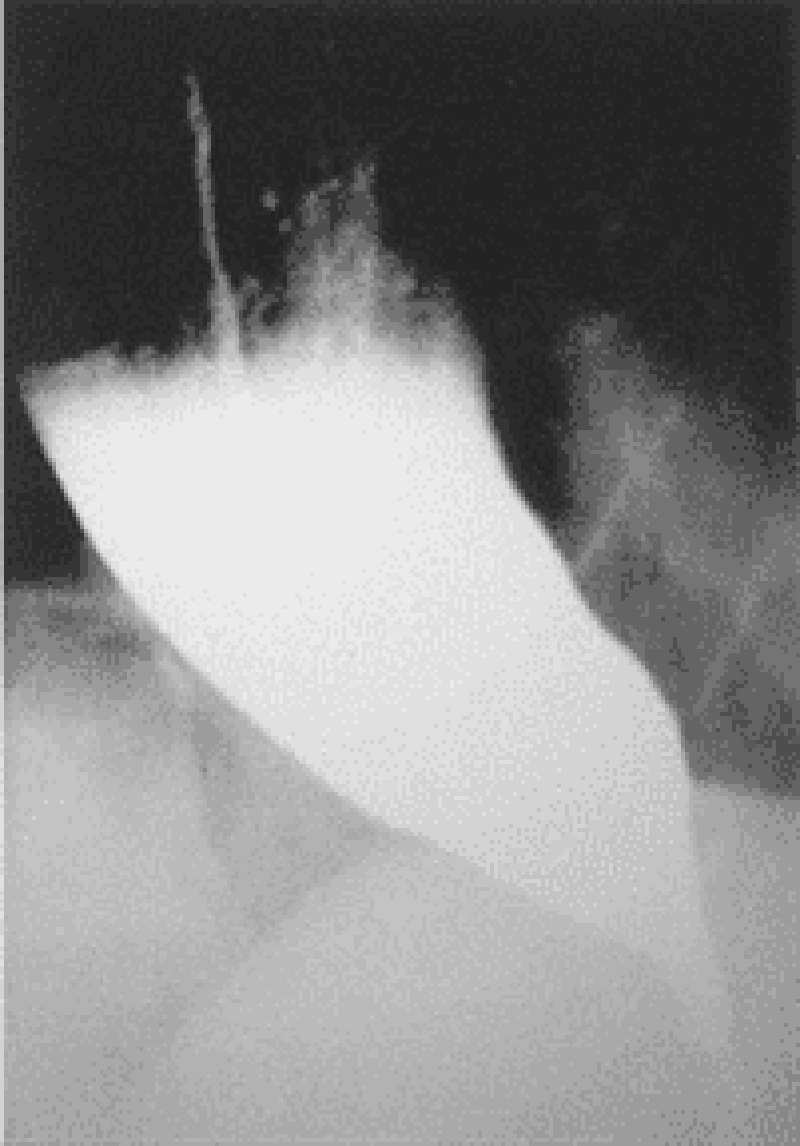
148) A 65-year-old man presents to his physician complaining of difficulty swallowing, occasional chest pain, and regurgitation of food. Over the past 2 months he has lost about 7 kg (15 lb). Results of a barium swallow study are shown in the image. What test should be performed to look for possible causes of his condition?
24-hour pH monitoring
Esophageal manometry
Serum gastrin level measurement
Upper endoscopy
Urease breath test
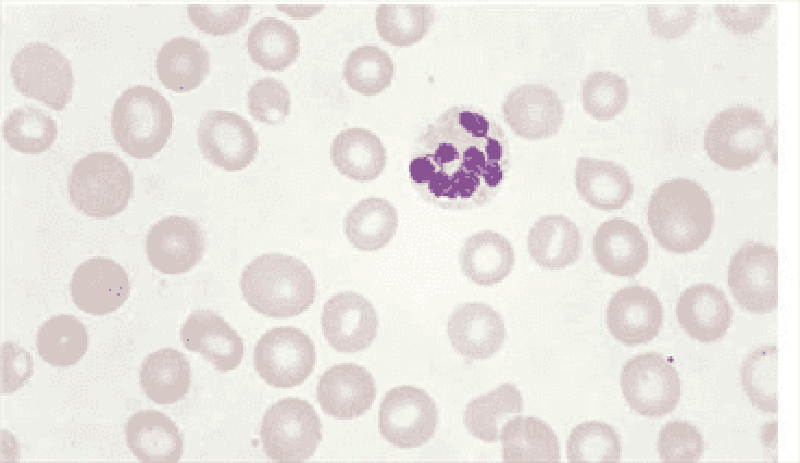
172) A 74-year -old Caucasian man is evaluated for occasional palpitations and poor exercise tolerance. He has been living alone since his wife died two years ago. His diet consists mainly of precooked food that he heats up in the microwave oven. He has a history of degenerative joint disease and hypertension. He takes a daily aspirin, hydrochlorothiazide, and glucosamine. He quit smoking 20 years ago and occasionally drinks alcohol. His peripheral blood smear is shown below. Which of the following substances is most likely elevated in this patient's blood?
. Ferritin
. Methionine
. Haptoglobin
. Homocysteine
. Cobalamin
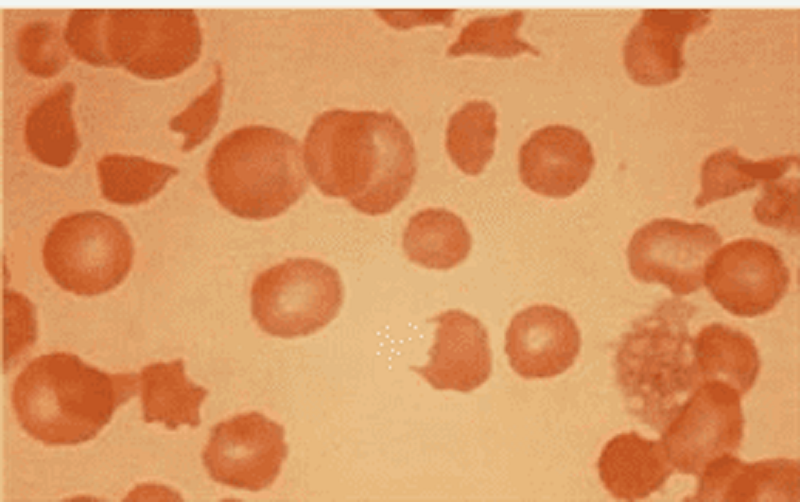
11) A 56-year-old male is being evaluated for increased fatigability. His past medical history is significant for severe aortic stenosis that required aortic valve replacement, diabetes mellitus, and osteoarthritis. Peripheral blood smear findings are shown on the slide below. Which of the following laboratory findings would you most expect to find in this patient?
. Increased total serum iron level
. Decreased serum haptoglobin level
. Increased mean corpuscular volume
. Decreased reticulocyte count
. Decreased serum albumin level

46) A 30-year-old woman comes to the office due to the recent onset of fever, chills, and dysuria. Her temperature is 38.3°C (101.0°F), blood pressure is 110/70mm Hg, pulse is 68/min, and respirations are 15/min. Examination shows tenderness at the right costovertebral angle. Laboratory studies show WBC count of 16,000/microl with left shift. Urinalysis shows bacteriuria and pyuria. Her urine and blood is collected for culture and sensitivity. She is prescribed oral ciprofloxacin and sent home. After three days, she returns for a follow-up visit. She is still febrile, and the physical examination is unchanged. The blood cultures have no growth after 72 hours of incubation. Results of the urine culture show. Which of the following is the most appropriate next step in management?
. Start intravenous ampicillin and gentamicin
. Start intravenous ciprofloxacin
. Continue oral ciprofloxacin for another 10 days
. Perform renal ultrasound
. Renal CT scan
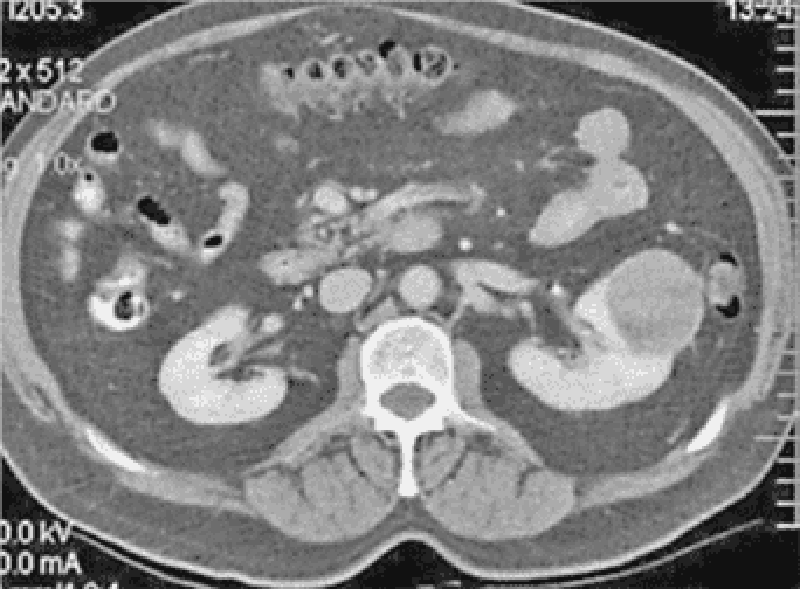
58) A 69-year-old woman presents with left flank pain and hematuria. Physical examination suggests a left-sided abdominal mass. Computerized tomography (CT) scan of the abdomen reveals a 5-cm mass in the left kidney. Which of the following laboratory abnormalities might also be present (See Fig.)?
Polycythemia
Thrombocytopenia
Hypocalcemia
Leukocytosis
High renin hypertension
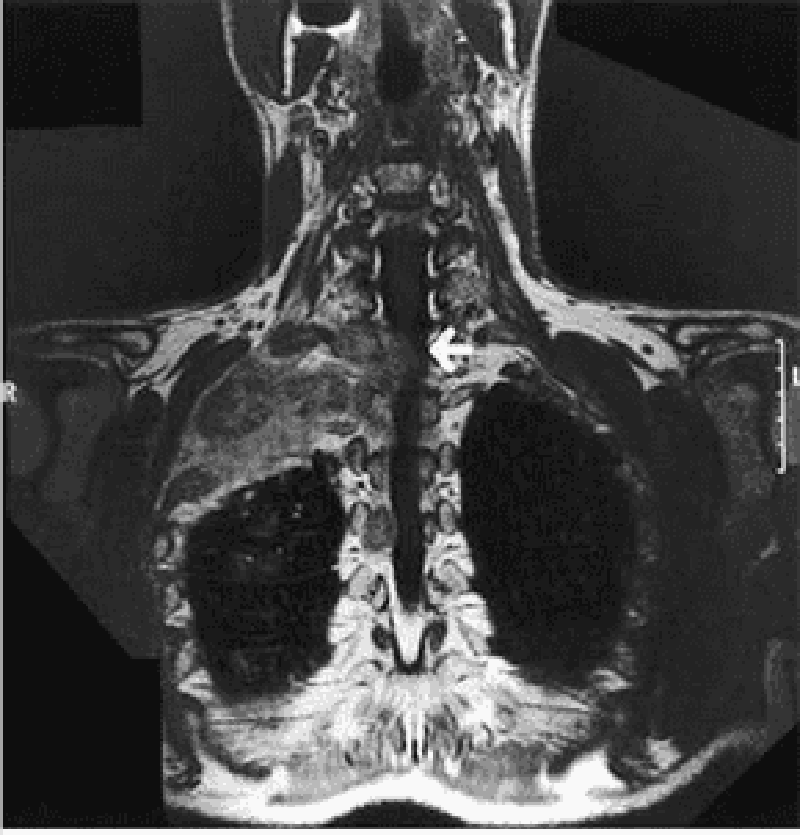
98) A 64-year -old African American male presents to you with complaints of a dry cough, weight loss and pain in his right arm. The symptoms started approximately 2 months ago. His past medical history is significant for type 2 diabetes mellitus and hypertension. He smokes 1 pack per day and drinks alcohol occasionally. He denies any drug allergies. Physical examination is unremarkable. ECG reveals normal sinus rhythm. An MRI of his chest is shown below. Which of the following is most likely responsible for this patient's symptoms?
. Aspergilloma
. Bronchial carcinoid
. Superior sulcus tumor
. Cryptogenic organizing pneumonia
. Lung abscess
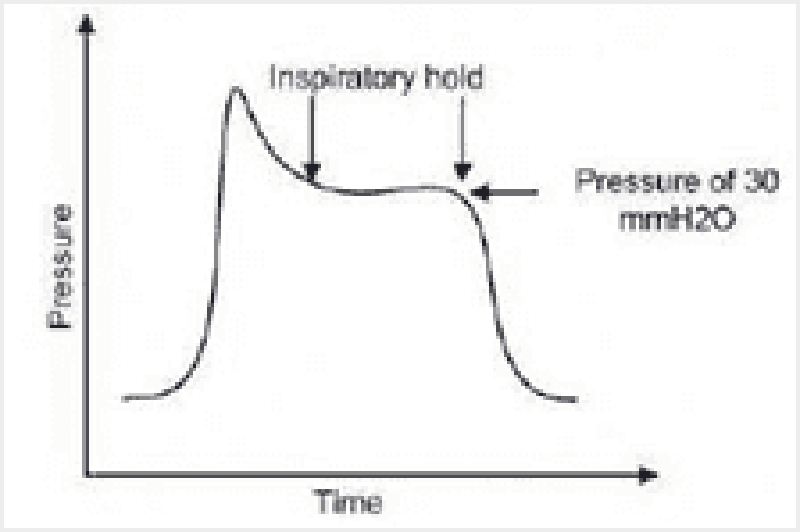
113) A 32-year-old man is intubated and mechanically ventilated after an opioid drug overdose. The ventilator triggers 12 breaths per minute, each delivering 500 ml of tidal volume at a flow rate of 60 L/min. You perform an inspiratory hold for 2 seconds following delivery of the tidal volume, and the airway pressure is measured to be 30 cm H2O. The measured pressure reflects which of the following?
. Upper airway resistance
. Total airway resistance
. Pulmonary compliance
. Expiratory muscle strength
. End-expiratory pressure
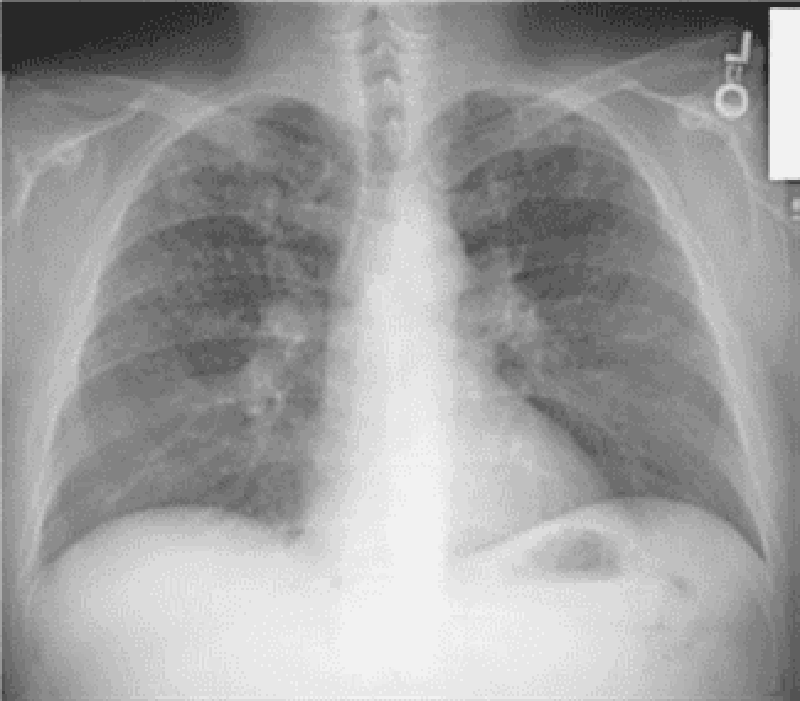
133) A 21-year-old man has a nonproductive cough, shortness of breath, and chest pain, which changes with breathing. He also has pain in the left arm. On examination, there is tender- ness over the left shoulder, heart sounds are normal, and the lungs are clear. CXR reveals a lytic lesion in the left humerus and reticulonodular opacities in the upper and middles lobes. The eosinophil count is normal. Which of the following is the most appropriate initial diagnostic test?
Lung biopsy
Humerus bone biopsy
CT scan of chest
Bronchoscopy
Pulmonary function tests
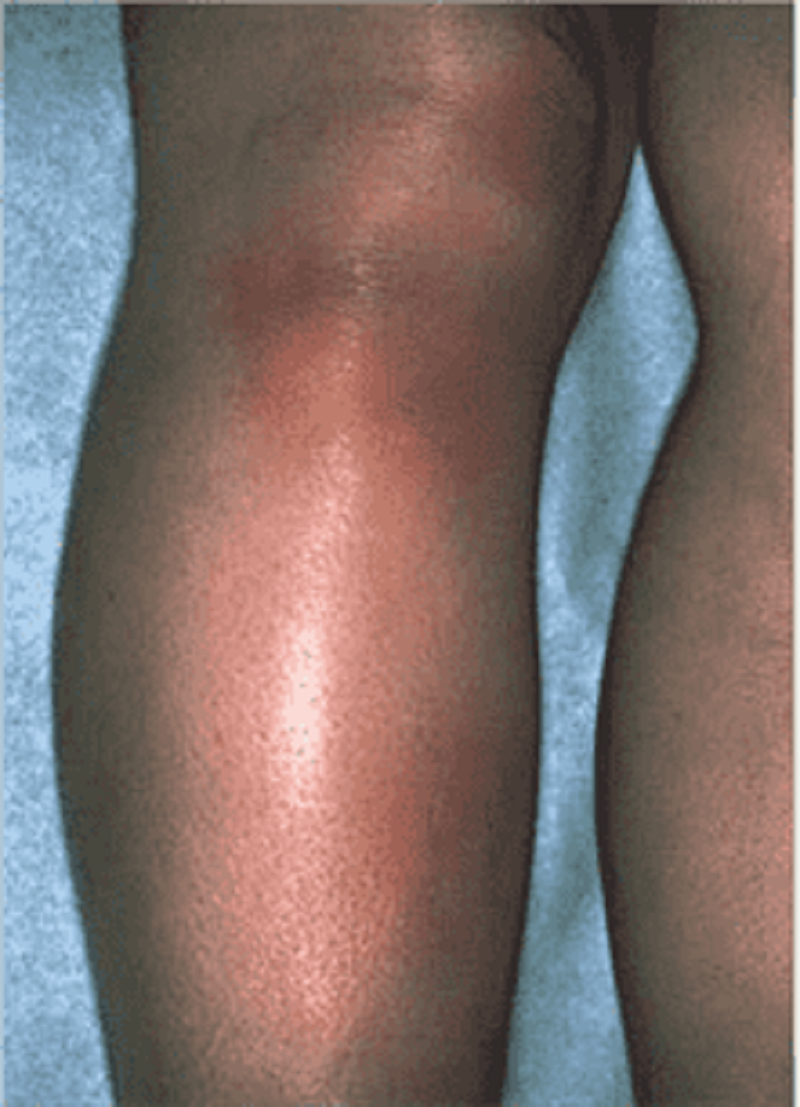
160) A 33-year-old African-American woman presents with one week of painful skin lesions on her legs. She has no cough, shortness of breath or bowel symptoms, and denies any recent illness or travel. She has no other significant past medical history and does not take any medication. She smokes one pack of cigarettes and drinks one glass of wine daily. She denies a history of sexually transmitted diseases and has been married to a monogamous partner for the past eight years. Her mother was diagnosed with ovarian cancer at age 65. Her temperature is 37.2°C (98.9°F), and blood pressure is 126/76 mmHg. On examination, she has multiple tender pink to reddish nodules noted below the knee on the extensor surface, as shown below. Which of the following is the most appropriate next step in her management?
. CT scan of the abdomen
. HIV testing
. Chest x-ray
. Rectal swab for culture
. Colonoscopy
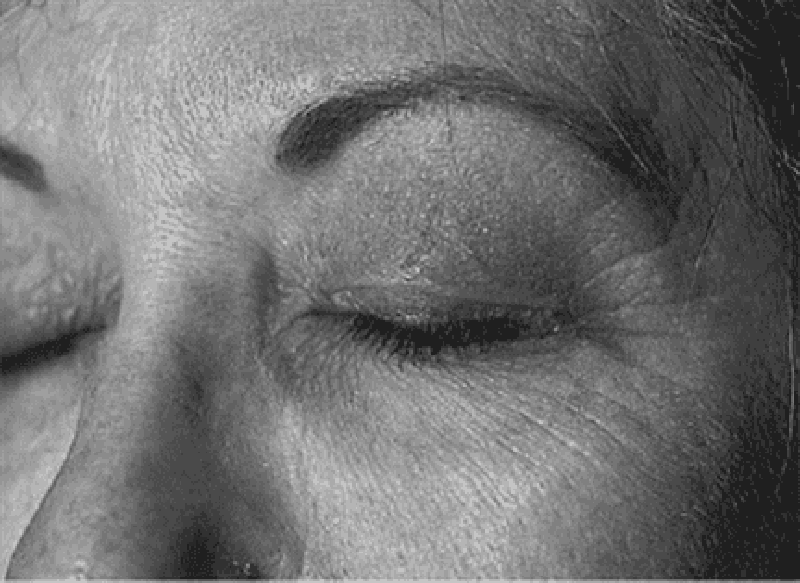
168) Over the last six weeks a 45-year-old nurse has developed progressive difficulty getting out of chairs and climbing stairs. She can no longer get in and out of the bathtub. She has no muscle pain and takes no regular medications. She does not use alcohol and does not smoke cigarettes. On examination she has a purplish rash that involves both eyelids (see figure). There is weakness of the proximal leg muscles. What is the best next diagnostic test?
. Vitamin B12 level
. Chest x-ray
. HLAB27
. MRI scan of the lumbar spine
. CPK
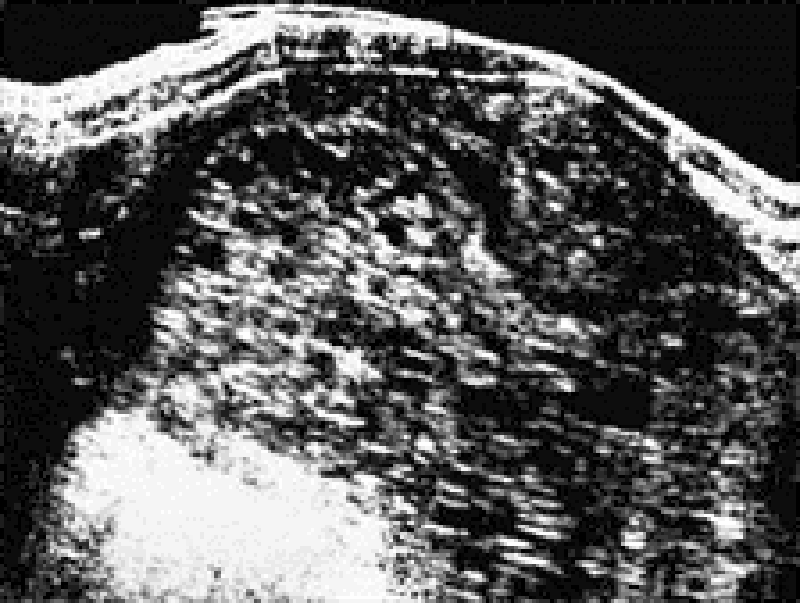
69) A 19-year-old primigravida is expecting her first child; she is 12 weeks pregnant by dates. She has vaginal bleeding and an enlarged-for-dates uterus. In addition, no fetal heart sounds are heard. The ultrasound shown below is obtained. Which of the following is true regarding the patient’s diagnosis?
. The most common chromosomal makeup of a partial or incomplete mole is 46XX, of paternal origin
. Older maternal age is not a risk factor for hydatidiform mole
. Partial or incomplete hydatidiform mole has a higher risk of developing into choriocarcinoma than complete mole
. Vaginal bleeding is a common symptom of hydatidiform mole
. Hysterectomy is contraindicated as primary therapy for molar pregnancy in women who have completed childbearing
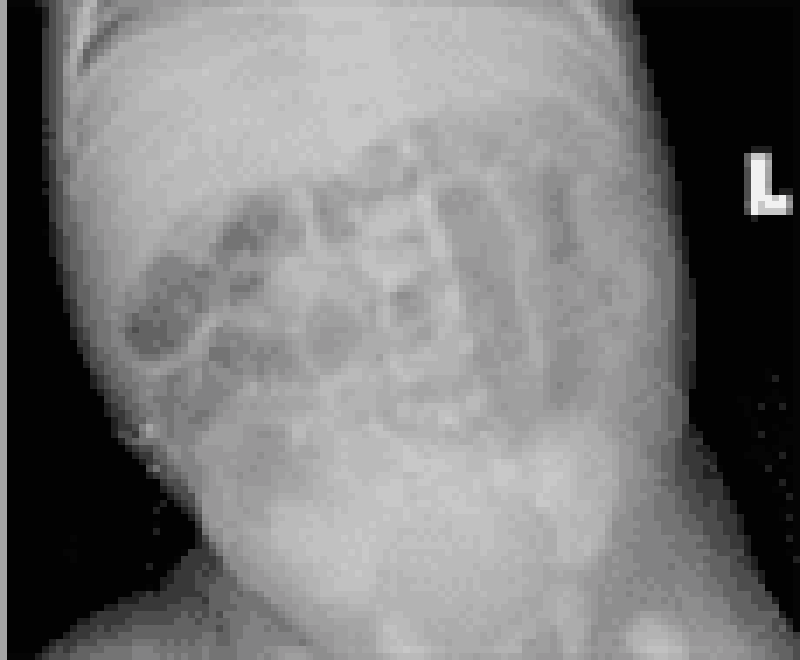
12) A 2-day-old boy in the newborn nursery was born at 39 weeks gestation to a 38-year-old woman by vaginal delivery. The mother received epidural fentanyl for severe painful contractions during labor, but the delivery was uncomplicated. Since birth, the boy has shown little interest in breast or bottle feeding. He spit up the last feed but has not vomited. He has not yet passed meconium. Physical examination shows a newborn with generalized hypotonia, a flat facial profile, low-set folded earlobes, and a single transverse crease on each palm. His abdomen is firm and distended. Digital rectal examination is notable for a tight anal canal and relieves an expulsion of gas and stool. Abdominal x-ray shows markedly distended loops of bowel with no gas in the rectum. What is the mostly likely mechanism for his findings?
. Constipation from decreased levels of thyroxine
. Failure of neural crest cell migration during fetal intestinal development
. Intestinal ileus from exposure to maternal epidural analgesia
. Intestinal obstruction from inspissated meconium
. Invagination of a part of the intestine into itself

32) A 10-year-old boy presents with a 1-day history of fever, cough, and chest pain. He has not been eating and has been listless. He does not have any previous history of health problems. On physical examination, his temperature is 40°C, and he is tachypneic. He looks ill. He has rales on his left posterior lower lung fields. You order a chest x-ray. Which of the following organisms is most likely responsible for his pneumonia?
Haemophilus influenzae
Mycoplasma pneumoniae
Pneumocystis carinii
Staphylococcus aureus
Streptococcus pneumoniae
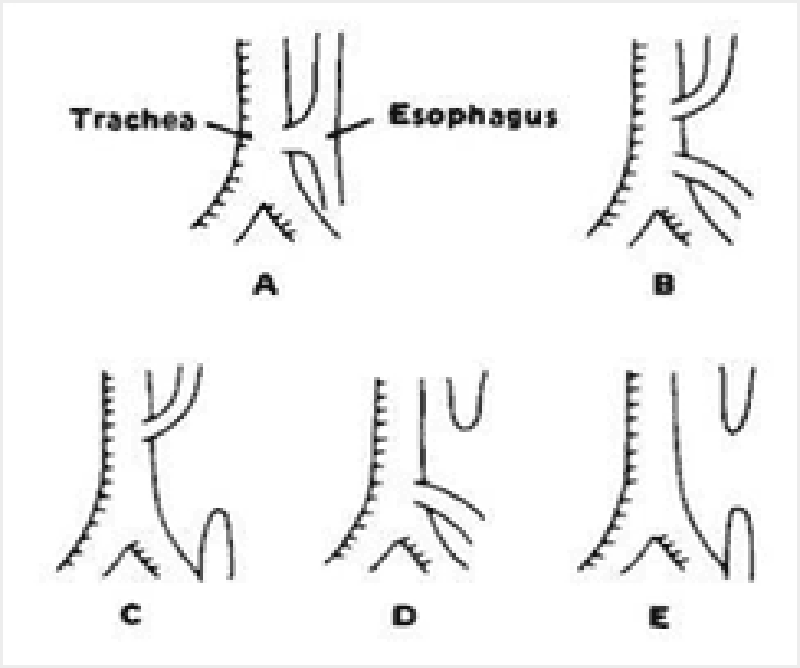
111) Shortly after birth, an infant develops abdominal distention and begins to drool. When she is given her first feeding, it runs out the side of her mouth, and she coughs and chokes. Physical examination reveals tachypnea, inter- costal retractions, and bilateral pulmonary rales. The esophageal anomaly that most commonly causes these signs and symptoms is illustrated by which of the following?
Figure A
Figure B
Figure C
Figure D
Figure E
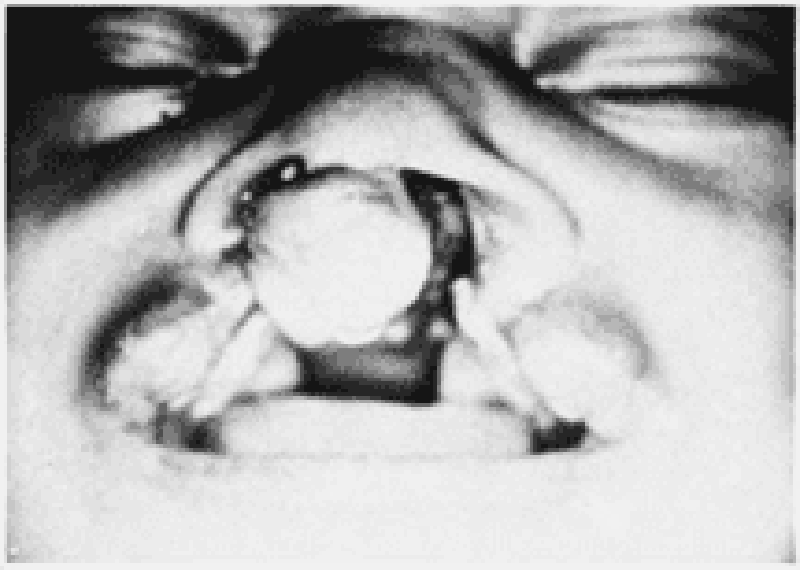
113) You see the newborn baby shown below for the first time in the nursery. You consult plastic and reconstructive surgeon as well as the hospital’s speech therapist. Understandably, the parents have many questions. Which of the following statements is appropriate anticipatory guidance for this family?
Parenteral alimentation is recommended to prevent aspiration
Surgical closure of the palatal defect should be done before 3 months of age
Good anatomic closure will preclude the development of speech defects
Recurrent otitis media and hearing loss are likely complications
The chance that a sibling also would be affected is 1 in 1000
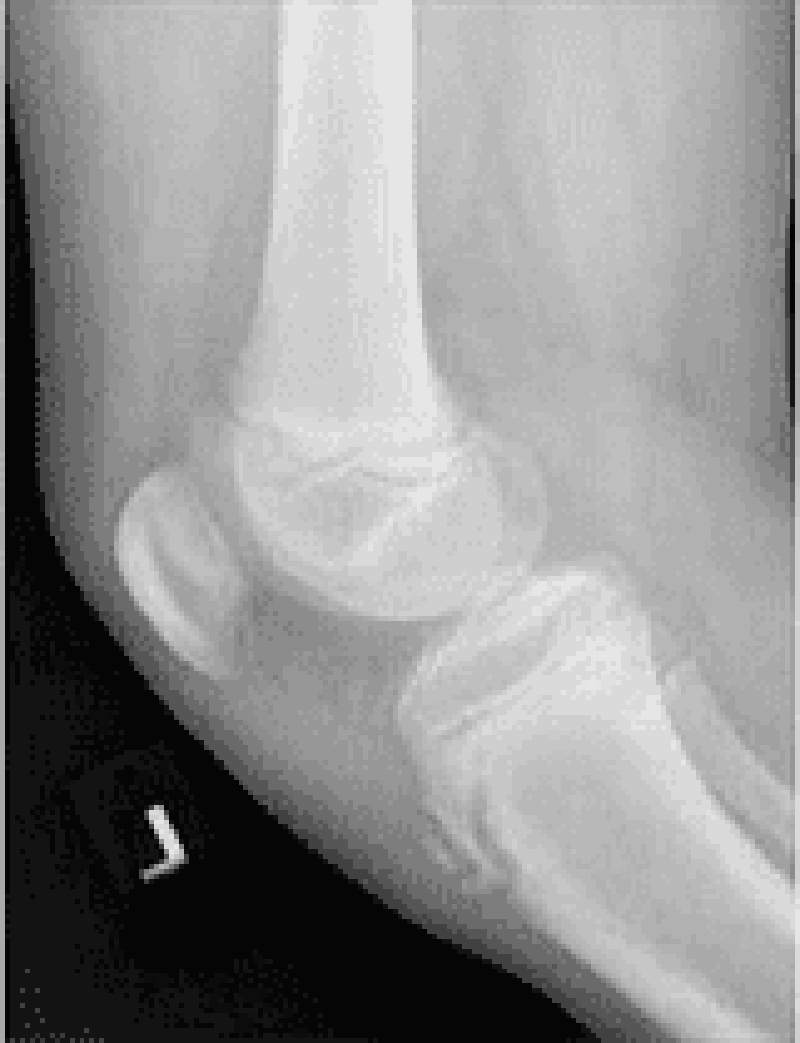
114) A 13-year-old male is brought to the physician for evaluation of intermittent left knee pain that arose three months ago. He does not remember any trauma to his knee. The pain worsens after basketball games, but improves some with rest. He has been taking non-steroidal anti-inflammatory medications with some relief. On physical examination, he has edema and tenderness over the proximal tibia at the site of the patellar tendon insertion. Examination of the knee joint is normal and no effusion is present. His knee pain is reproducible by extending the knee against resistance. A lateral radiograph of his knee is shown below. Which of the following is the most likely cause of this patient's knee pain?
Prepatellar bursitis
Traction apophysitis
Patellar tendonitis
Tibial osteomyelitis
Patellofemoral stress syndrome
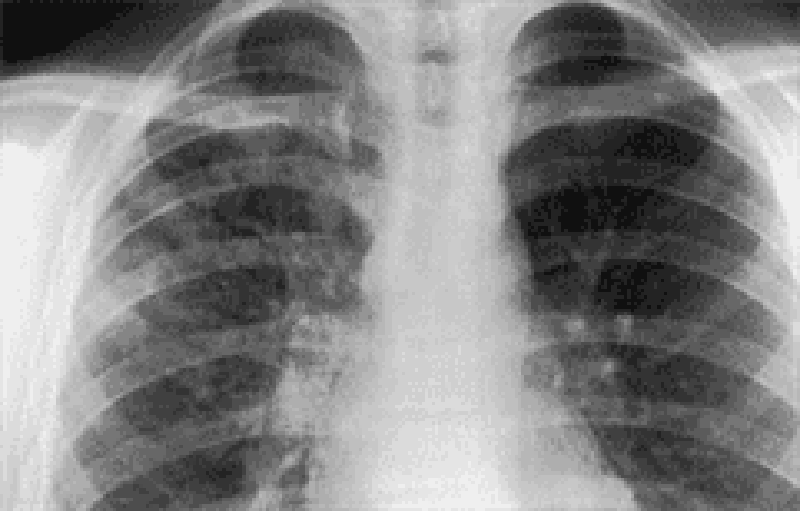
151) A 13-year-old develops fever, malaise, sore throat, and a dry, hacking cough over several days. He does not appear to be particularly sick, but his chest examination is significant for diffuse rales and rhonchi. The chest radio- graph is shown below. Which of the following is the most likely pathogen?
Staphylococcus aureus
Mycobacterium tuberculosis
Haemophilus influenzae
Streptococcus pneumoniae
Mycoplasma pneumoniae
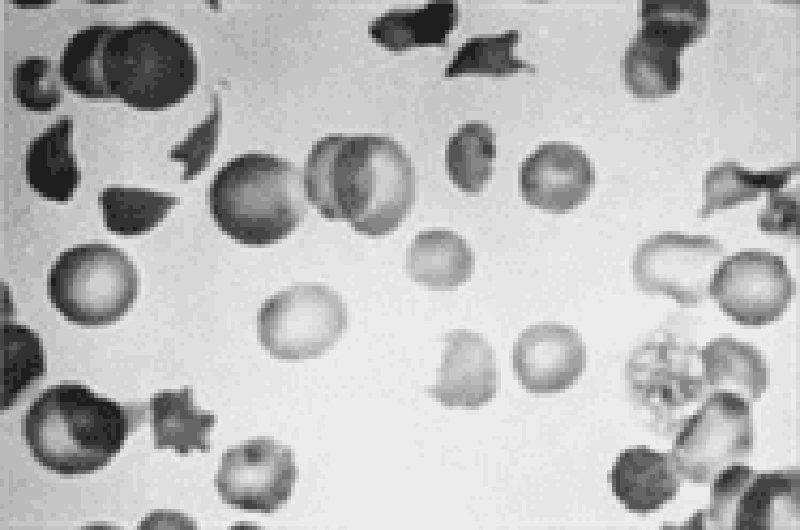
167) A 2-year-old child in shock has multiple nonblanching purple lesions of various sizes scattered about on the trunk and extremities; petechiae are noted, and oozing from the venipuncture site has been observed. The child’s peripheral blood smear is shown below. Clotting studies are likely to show which of the following?
. Increased levels of factor V and VIII
. A decreased prothrombin level
. An increased fibrinogen level
. The presence of fibrin split products
. Normal partial thromboplastin time (PTT)
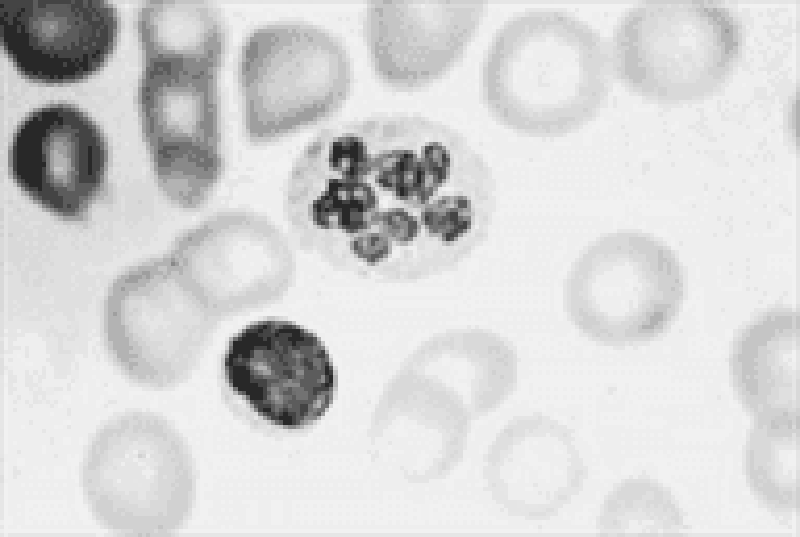
176) An otherwise healthy child has on his 1-year-old routine CBC the polymorphonuclear neutrophil shown below. This child likely has which of the following?
. Malignancy
. Iron deficiency
. Folic acid deficiency
. Döhle inclusion bodies
. The Pelger-Huët nuclear anomaly

206) A previously healthy 5-year-old boy has a 1-day history of low-grade fever, colicky abdominal pain, and a rash. He is well-appearing and alert. His vital signs, other than a temperature of 38°C (100.5°F) are completely normal. A diffuse, erythematous, maculopapular, and petechial rash is present on his buttocks and lower extremities, as shown in the photograph. He has no localized abdominal tenderness or rebound; bowel sounds are active. Laboratory data demonstrate Urinalysis: 30 red blood cells (RBCs) per high-powered field, 2+ protein. Stool: Guaiac positive Platelet count: 135,000/μL. These findings are most consistent with which of the following?
Anaphylactoid purpura
Meningococcemia
Child abuse
Leukemia
Hemophilia B
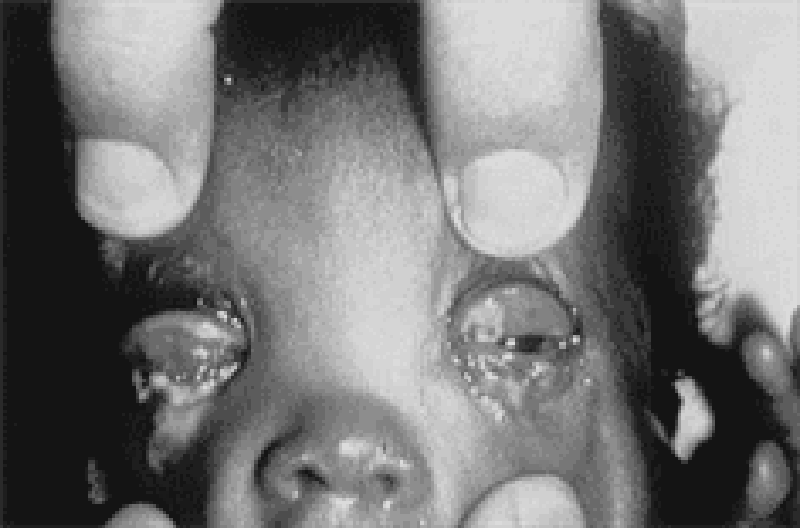
10) The newborn pictured below was born at home and has puffy, tense eye- lids; red conjunctivae; a copious amount of purulent ocular discharge; and chemosis 2 days after birth. Which of the following is the most likely diagnosis?
Dacryocystitis
Chemical conjunctivitis
Pneumococcal ophthalmia
Gonococcal ophthalmia
Chlamydial conjunctivitis
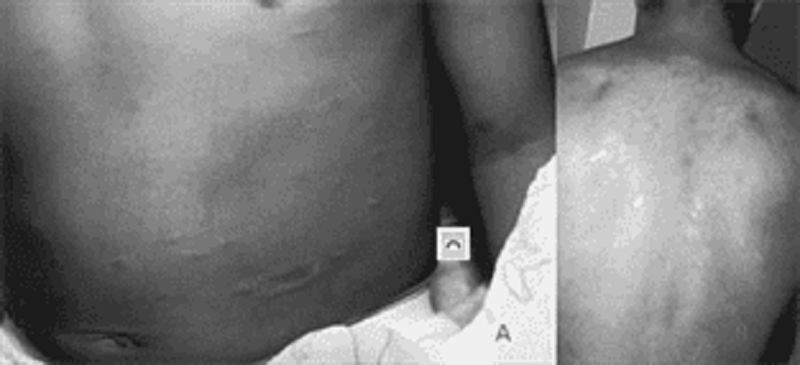
29) The adolescent shown presents with a 14-day history of multiple oval lesions over her back. The rash began with a single lesion over the lower abdomen (Image A); the other lesions developed over the next days (image B). These lesions are slightly pruritic. Which of the following is the most likely diagnosis?
Contact dermatitis
Pityriasis rosea
Seborrheic dermatitis
Lichen planus
Psoriasis
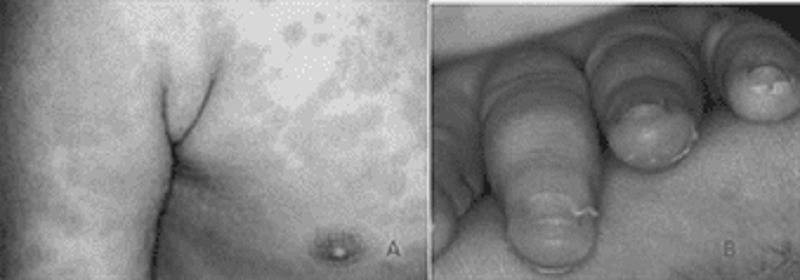
41) A 2-year-old boy is brought into the emergency room with a complaint of fever for 6 days and the development of a limp. On examination, he is found to have an erythematous macular exanthem over his body as shown in (image A), ocular conjunctivitis, dry and cracked lips, a red throat, and cervical lymphadenopa- thy. There is a grade 2/6 vibratory systolic ejection murmur at the lower left sternal border. A white blood cell (WBC) count and differential show predominant neutrophils with increased platelets on smear. Later, he develops the findings as seen in (image B). Which of the following is the most likely diagnosis?
Scarlet fever
Rheumatic fever
Kawasaki disease
Juvenile rheumatoid arthritis
Infectious mononucleosis
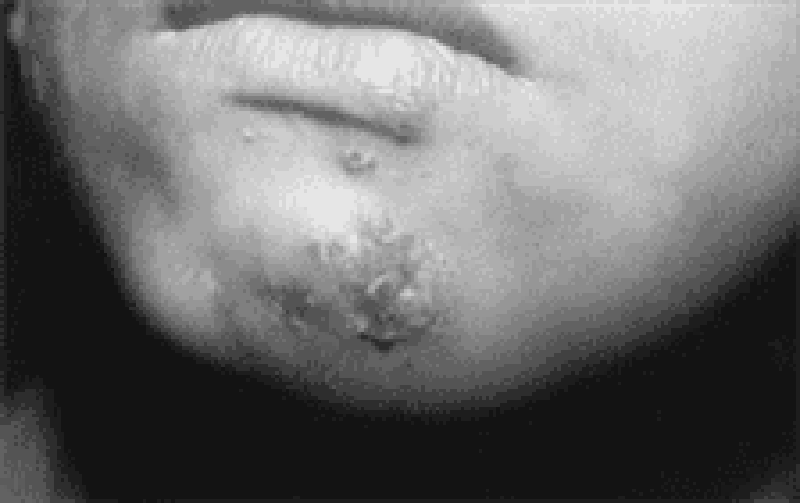
76) A boy has returned home from visiting his grandmother in a rural area. He spent most of his time swimming, playing in the yard, helping in the gardens, and chasing his Chihuahua; his grandma says “he was generally dirty!” He was noted 2 weeks ago to have “infected mosquito bites” on his neck and chin for which the local doctor had him just scrub with soap; a few remain and are shown in the photograph below. His mother brings him into the office with the complaint of dark urine, swelling around his eyes, and shortness of breath. You also find him to have hypertension and hepatomegaly. Which of the following is the most likely cause of his problem?
. IgA nephropathy
. Post streptococcal glomerulonephritis
. Idiopathic hypercalciuria
. Pyelonephritis
. Sexually transmitted disease

90) The mother of a 3-day-old infant brings her child to your office for an early follow-up visit. The mom notes that the child has been eating well, has had no temperature instability, and stools and urinates well. She notes that over the previous 3 days the child has had a progressive rash on the face as pictured here. Which of the following is the most likely diagnosis?
Herpes
Neonatal acne
Milia
Seborrheic dermatitis
Eczema
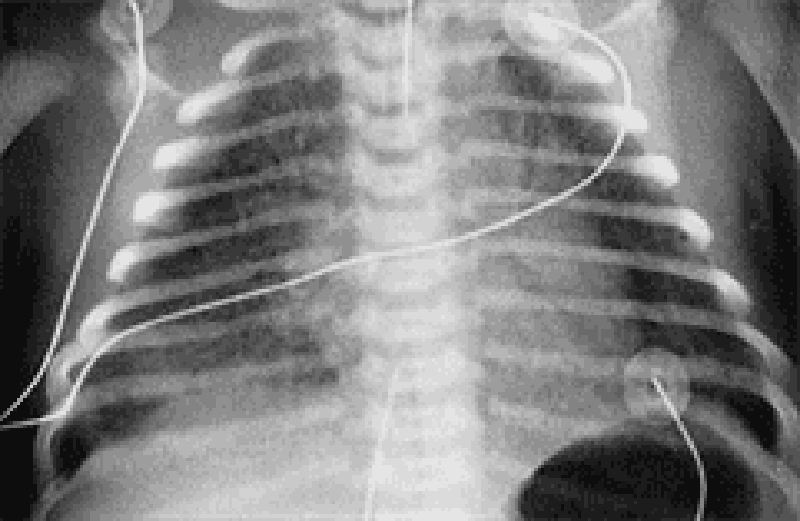
91) An 8-hour-old infant develops increased respiratory distress, hypothermia, and hypotension. A complete blood count (CBC) demonstrates a white blood cell (WBC) count of 2500/μL with 80% bands. The chest radiograph is shown below. Which of the following is the most likely diagnosis?
Congenital syphilis
Diaphragmatic hernia
Group B streptococcal pneumonia
Transient tachypnea of the newborn
Chlamydial pneumonia

101) Over the previous 2 to 3 weeks, a very active 13-year-old white boy is noted by his family to have developed deep pains in his leg that awaken him from sleep. The family brings him to your office with a complaint of a swelling over his distal leg, which he attributes to his being kicked while playing soccer about 1 week ago. He has had no fever, headaches, weakness, bruising, or other symptoms. A radiograph of the leg is shown below. Which of the following is the most likely explanation for his pain?
. Growingpains
. Leukemia
. Osteomyelitis
. Bone fracture
. Osteosarcoma
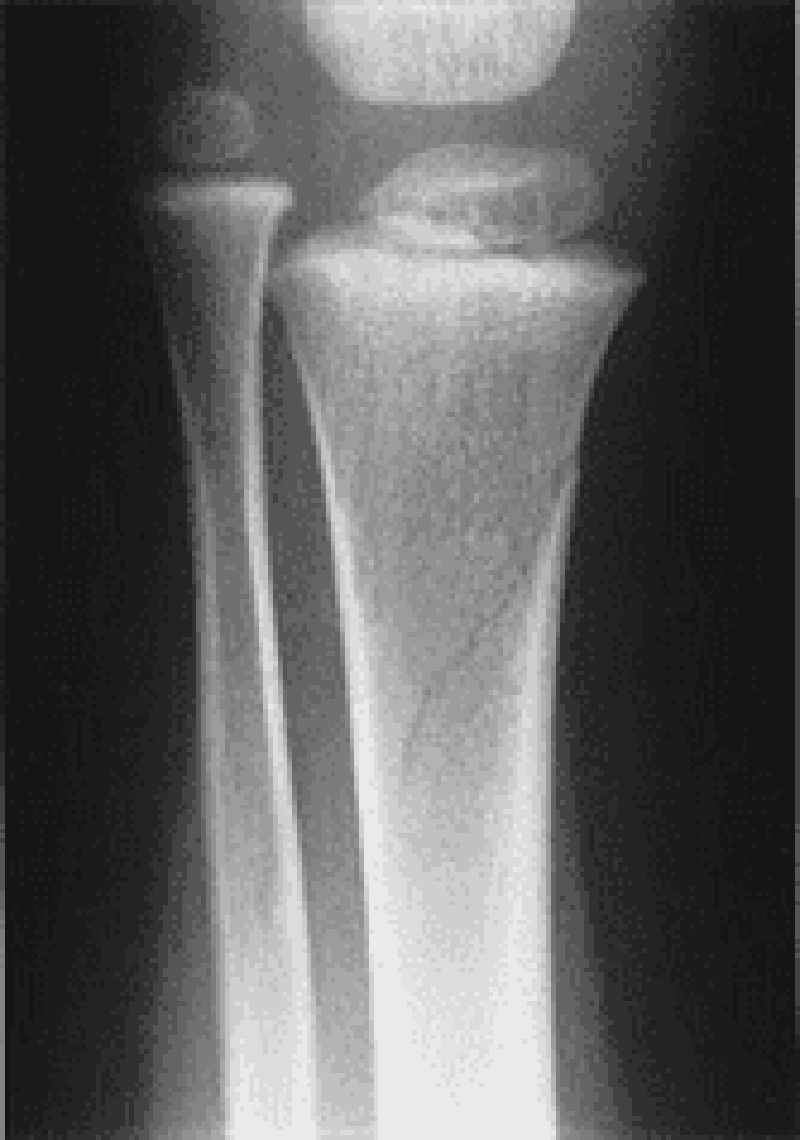
107) A 4-month-old baby boy arrives to the ER cold and stiff. The parents report that he had been healthy and that they put him to bed as usual for the night at the regular time. When they next saw him, in the morning, he was dead. Physical examination is uninformative. A film from a routine skeletal survey is shown below. Which of the following is the most likely diagnosis?
Scurvy
Congenital syphilis
Sudden infant death syndrome (SIDS)
Osteogenesis imperfecta
Abuse
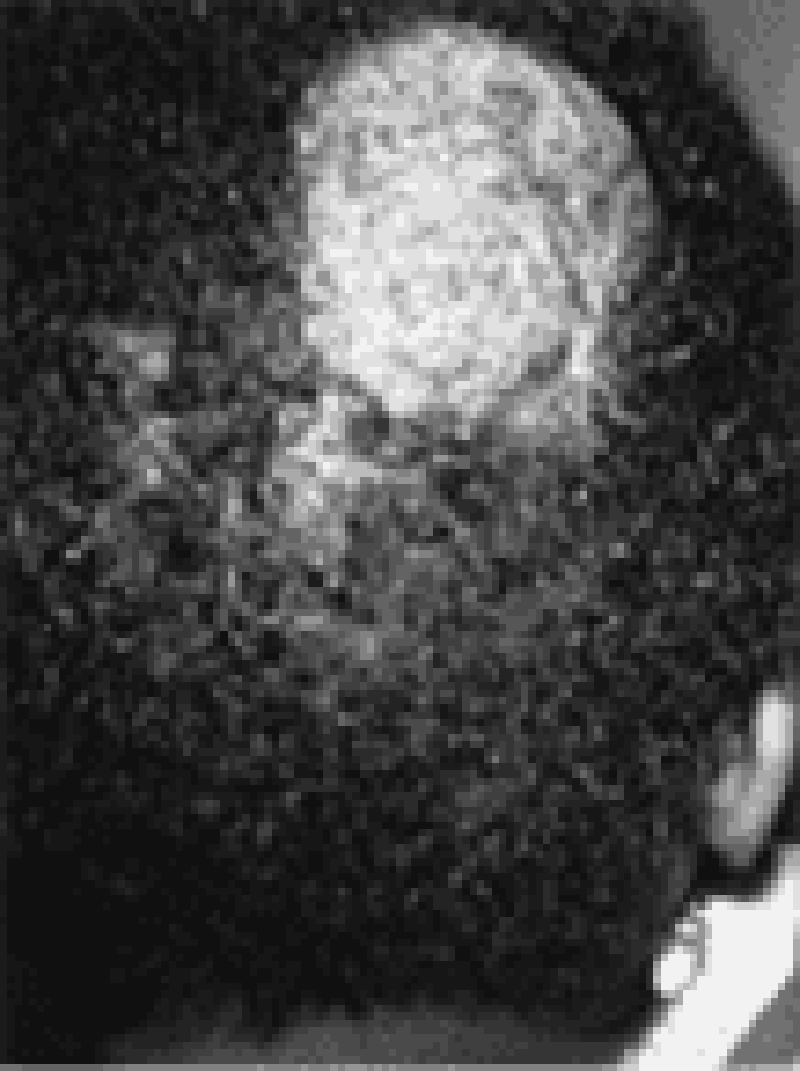
128) A patient with hair loss is shown below. The lesion does not fluoresce with a Wood lamp and has not responded well to a variety of topical agents. The lesion is boggy, is spreading, and has tiny pinpoint black dots throughout. Which of the following is the most likely diagnosis?
. Traction alopecia from tight hair braids
. Infection with Trichophyton tonsurans
. Alopecia areata
. Biotinidasedeficiency
. Hypothyroidism

131) The parents of the child pictured below bring him to the office for evaluation of short stature. At 5 years of age, he is the shortest child in his kindergarten class. His development is normal, and he is reading on a first grade level. Both parents are of normal height, and this child resembles no one in the family. Which of the following is the most likely diagnosis?
. Achondrogenesis
. Achondroplasia
. Metatropic dysplasia
. Thanatophoric dwarfism
. Chondroectodermal dysplasia
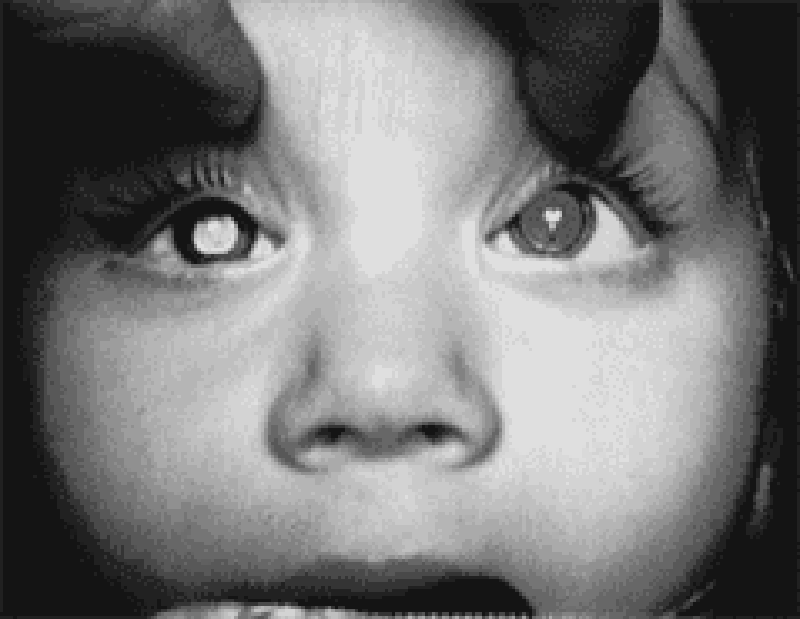
134) The 16-month-old male infant pictured below was recently brought from a developing country to the United States. The family history reveals that his father had an eye and a leg removed. Which of the following is the most likely diagnosis?
. Coloboma of the choroid
. Retinaldetachment
. Nematode endophthalmitis
. Retinoblastoma
. Persistent hyperplastic primary vitreous
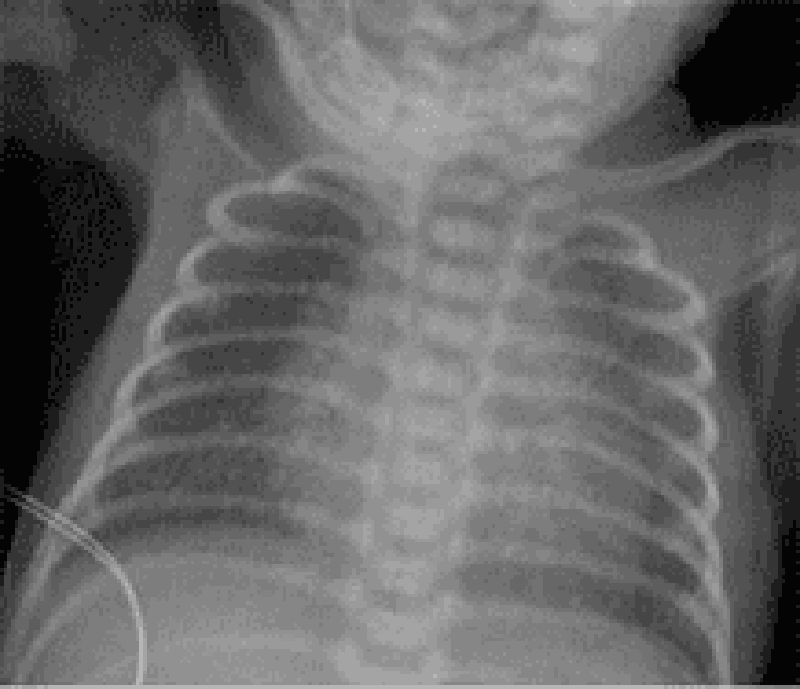
154) You are called to the delivery room to evaluate an infant born at 28-weeks gestational age. The infant is tachypneic and cyanotic. Examination reveals intercostal and subcostal retractions along with nasal flaring. Lungs have coarse breath sounds bilaterally. After initial resuscitation, the patient is given respiratory support with continuous positive airway pressure and admitted to the neonatal intensive care unit. The patient's respiratory status continues to worsen over the next 24 hours. A chest radiograph from the patient is shown below. In addition to prematurity, which of the following is a risk factor for the development of this disease?
Prolonged rupture of membranes
Intrauterine growth restriction
Maternal diabetes
Maternal hypertension
Antenatal corticosteroids
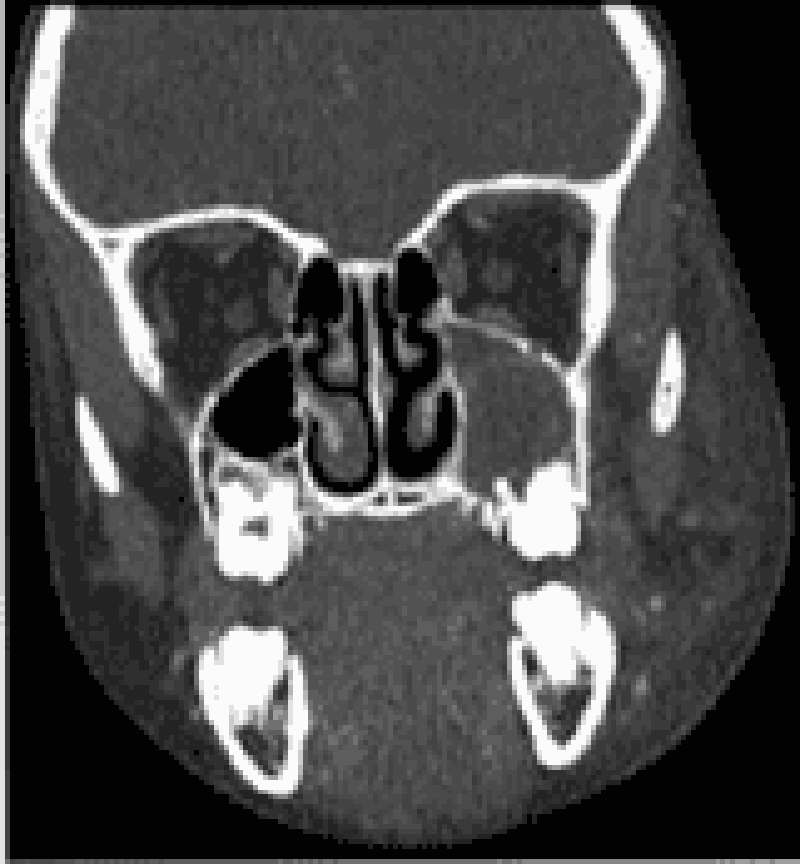
173) A 5-year-old girl is brought to the physician with low grade fever and rhinorrhea. Her symptoms began ten days ago. She has also had persistent purulent rhinorrhea, nasal congestion, and a dry cough during the day that worsens at night. Her symptoms do not seem to be improving. On examination, the child has erythema and swelling of the nasal turbinates with purulent nasal drainage. She has evidence of drainage in the posterior pharynx as well. The remainder of her examination is unremarkable. Computed topography of her face is shown below. Which of the following is the most common predisposing factor for her condition?
Allergic rhinitis
Septal deformities
Adenoidal hypertrophy
Environmental mucosal irritants
Viral upper respiratory infection
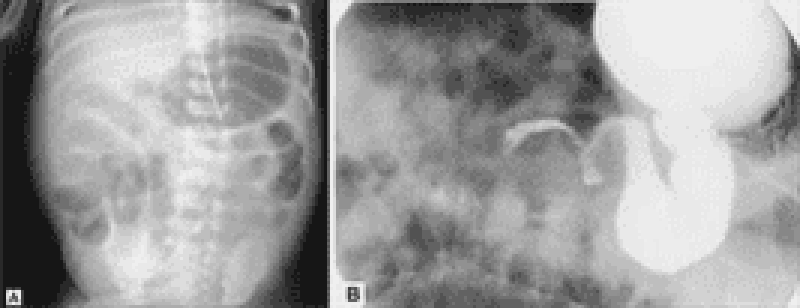
174) A 1-week-old previously healthy infant presents to the emergency room with the acute onset of bilious vomiting. The abdominal plain film in the emergency department (Image A) and the barium enema done after admission (Image B) are shown. Which of the following is the most likely diagnosis for this patient?
. Jejunal atresia
. Hypertrophic pyloric stenosis
. Malrotation with volvulus
. Acute appendicitis
. Intussusception

182) The 4-year-old child pictured below is noted to have the tooth decay as shown. This characteristic pattern of tooth decay is caused by which of the following?
. Excessive use of fluoride
. Tetracycline
. Use of bottled water that lacks fluoride
. Prolonged use of a baby bottle
. Consumption of too much candy
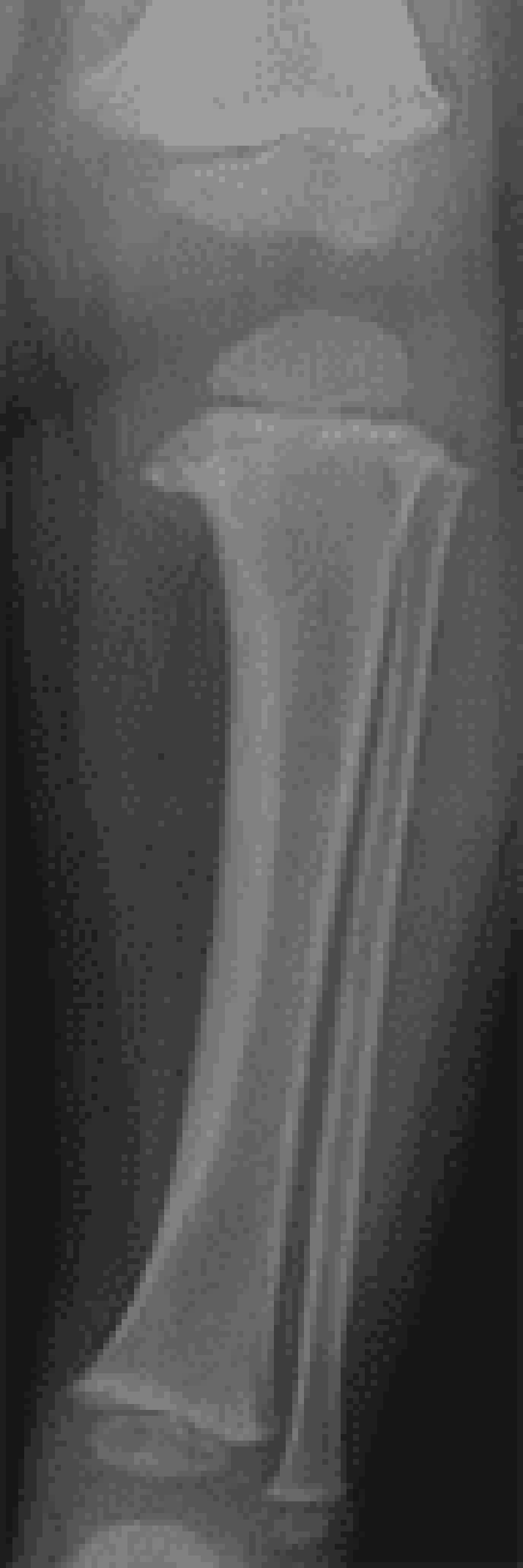
183) A 2-year-old child presents to the office with a paternal complaint of “bowlegs.” The girl has always had bowlegs; her previous pediatrician told the family she would grow out of it. Now, however, it seems to be worsening. Her weight is greater than 95% for age, and she has significant bowing out of her legs and internal tibial torsion; otherwise, her examination is normal. A radiograph of her lower leg is shown. Which of the following is the most likely diagnosis?
Osgood-Schlatter disease
Physiologic genu varum
Slipped capital femoral epiphysis
Legg-Calvé-Perthes disease
Blount disease

192) The delivery of a newborn boy is remarkable for oligohydramnios. The infant (pictured) is also noted to have undescended testes and clubfeet, and to be in respiratory distress. Which of the following is the most likely diagnosis to explain these findings?
.Surfactant deficiency
.Turner syndrome
.Prune belly syndrome
.Hermaphroditism
.Congenital adrenal hyperplasia

196) A term, 4200-g (9-lb, 4-oz) female infant is delivered via cesarean section because of cephalopelvic disproportion. The amniotic fluid was clear, and the infant cried almost immediately after birth. Within the first 15 minutes of life, however, the infant’s respiratory rate increased to 80 breaths per minute, and she began to have intermittent grunting respirations. The infant was transferred to the level 2 nursery and was noted to have an oxygen saturation of 94%. The chest radiograph is shown. Which of the following is the most likely diagnosis?
Diaphragmatic hernia
Meconium aspiration
Pneumonia
Idiopathic respiratory distress syndrome
Transient tachypnea of the newborn
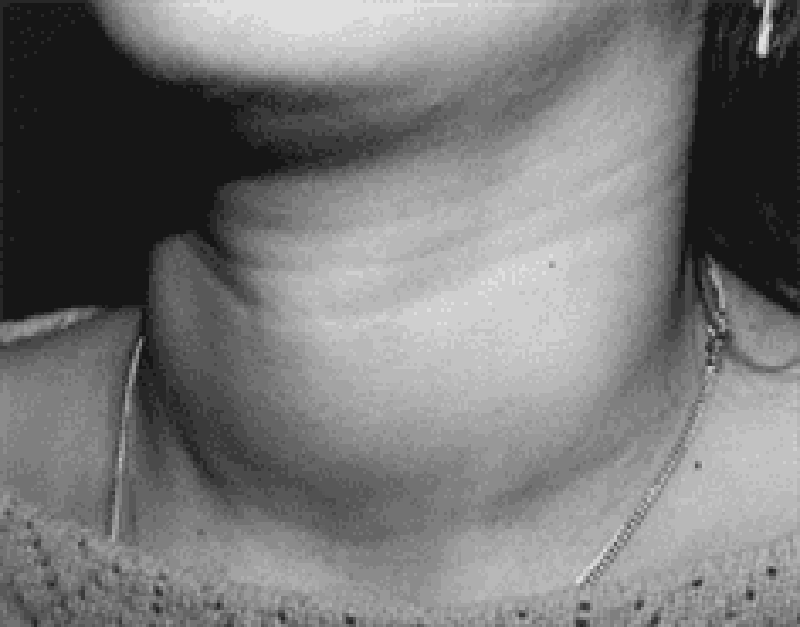
204) A 13-year-old asymptomatic girl is shown below. She states that the findings demonstrated began more than a year ago. Which of the following is the most likely diagnosis?
. Iodine deficiency
. Congenital hypothyroidism
. Graves’ disease
. Exogenous ingestion of Synthroid
. Lymphocytic (Hashimoto) thyroiditis

206) A 4-year-old boy presents to the physician with fever and a sore throat. His illness began with rhinorrhea, cough, and congestion one week ago, but in the last 24 hours he has developed fever, a sore throat, and neck pain. His mother also reports that he sounds hoarse. His appetite is decreased and he complains of dysphagia. His temperature is 39.7 C (103.5F), pulse is 100/min, and respiratory rate is 25/min. On examination, the child appears sick. He has cervical lymphadenopathy on the right and decreased range of motion of his neck. His voice is muffled and sounds hoarse. His oropharynx is erythematous and a bulge is noted in the posterior pharyngeal wall. A lateral radiograph of the neck is shown below. Which of the following is the most likely diagnosis?
. Diphtheria
. Viral pharyngitis
. Epiglottitis
. Infectious mononucleosis
. Retropharyngeal abscess
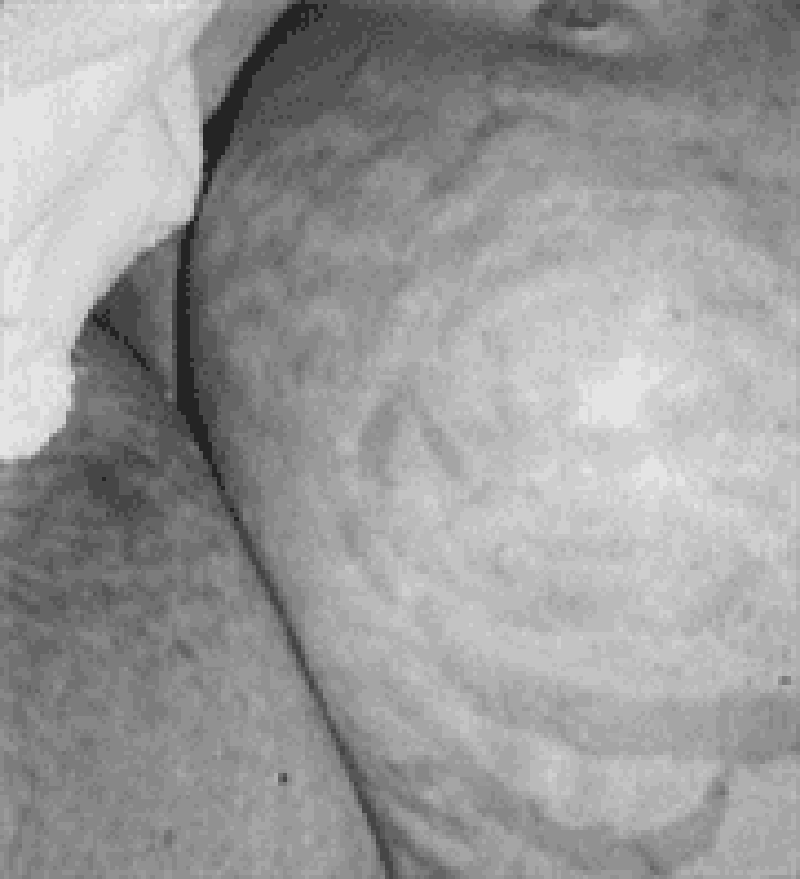
207) A 10-year-old obese child (shown below) has central fat distribution, arrested growth, hypertension, plethora, and osteoporosis. Which of the following disorders is most likely responsible for the clinical picture that this boy presents?
. Bilateral adrenal hyperplasia
. Adrenaladenoma
. Adrenal carcinoma
. Craniopharyngioma
. Ectopic adrenocorticotropin-producing tumor
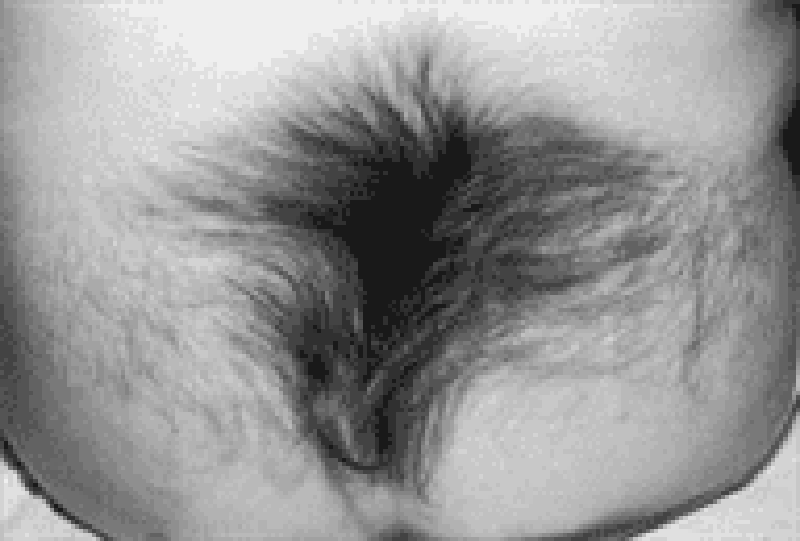
211) The examination of a child’s back is shown below. Evaluation with ultrasound of this lesion may demonstrate which of the following?
. Epsteinpearl
. Mongolian spot
. Cephalohematoma
. Omphalocele
. Occult spina bifida

216) A previously healthy 4-year-old boy is brought to the physician for evaluation of fever and respiratory distress. The patient developed fever three days ago. Since then, he has had increasing fatigue, irritability, and respiratory distress. His temperature is 100 F (38.2C), pulse is 144/min, respiratory rate is 45/min, and blood pressure is 95/60 mm Hg. On examination, the child appears to be in moderate respiratory distress with tachypnea and subcostal retractions. He is tachycardic with an III/IV holosystolic murmur best heard at the cardiac apex. Peripheral pulses are present and capillary refill is three seconds. His liver is palpated three centimeters below the costal margin. A chest radiograph is shown below. Which of the following is the most likely cause of this patient's symptoms?
Community-acquired pneumonia
Viral hepatitis
Rheumatic fever
Kawasaki disease
Myocarditis

242) A 24-year-old woman arrives in the emergency center in active labor. She is at term, but received no prenatal care after 16 weeks of gestation when she lost her insurance coverage. The mother has an uncomplicated vaginal delivery. You are paged shortly after birth when the baby is noted to have respiratory distress. The infant has diminished breath sounds on the left, and the PMI is shifted toward the right. A chest radiograph is shown. The NG tube you placed earlier reveals the stomach to be below the diaphragm. Which of the following is the most likely diagnosis at this point?
Congenital cystic adenomatoid malformation
Congenital diaphragmatic hernia
Bronchogenic cysts
Congenital lobar emphysema
Congenital pneumonia

244) The 1-year-old boy in the photograph below, who recently had a circumcision, requires an additional operation on his genitalia that will probably eliminate his risk of which of the following?
. Testicular malignancy
. Decreased sperm count
. Torsion of testes
. Urinary tract infection
. Epididymitis

246) The term infant pictured below weighs 2200 g (4 lb, 14 oz). He is found to have a ventricular septal defect on cardiac evaluation. This infant appears to have features consistent with which of the following?
Perinatal phenytoin exposure
Trisomy 21
Alport syndrome
Fetal alcohol syndrome
Infant of diabetic mother

255) A 15-year-old boy comes to the physician with left shoulder joint pain and swelling. He has had these symptoms for the past 3 months and they are getting progressively worse. He has no fever, weight loss, or night sweats. The patient lifts weights and plays baseball 5 days a week. He has taken acetaminophen and ibuprofen with little relief. Examination shows a tender mass at the left proximal humerus. Range of motion is normal. Laboratory evaluation shows elevated alkaline phosphatase, erythrocyte sedimentation rate, and lactate dehydrogenase. X-ray of the shoulder is shown in the photograph below. Which of the following is the most likely diagnosis?
Ewing sarcoma
Osteoid osteoma
Osteomyelitis
Osteosarcoma
Stress fracture
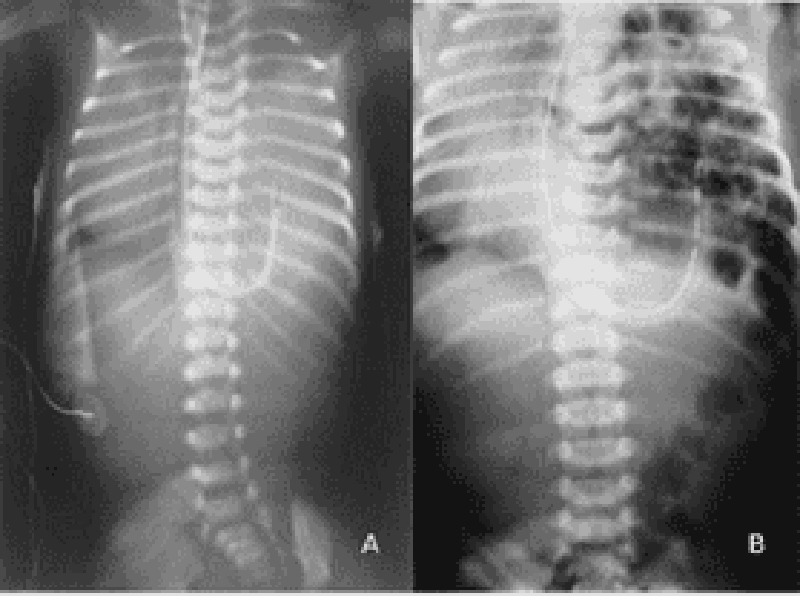
260) A newborn infant develops respiratory distress immediately after birth. His abdomen is scaphoid. No breath sounds are heard on the left side of his chest, but they are audible on the right. Immediate intubation is successful with little or no improvement in clinical status. Emergency chest x-ray is shown (Image A) along with an x-ray 2 hours later (Image B). Which of the following is the most likely explanation for this infant’s condition?
Pneumonia
Cystic adenomatoid malformation
Diaphragmatic hernia
Choanal atresia
Pneumothorax

280) You are called to the newborn nursery to evaluate a term infant with bilious emesis. Although the mother had poor prenatal care, she had a normal vaginal delivery with no complications. The infant began having bilious vomiting several hours after birth. The infant has urinated, but has not had a bowel movement. Vital signs are temperature 36.9 0C (98.4 0F), pulse 150/min, and respiratory rate 40/min. On examination, the abdomen is distended and there are decreased bowel sounds. The remainder of the physical examination is unremarkable. An abdominal radiograph is shown below. Which of the following is the most likely diagnosis?
Pyloric stenosis
Intestinal atresia
Hirschsprung disease
Necrotizing enterocolitis
Gastroesophageal reflux
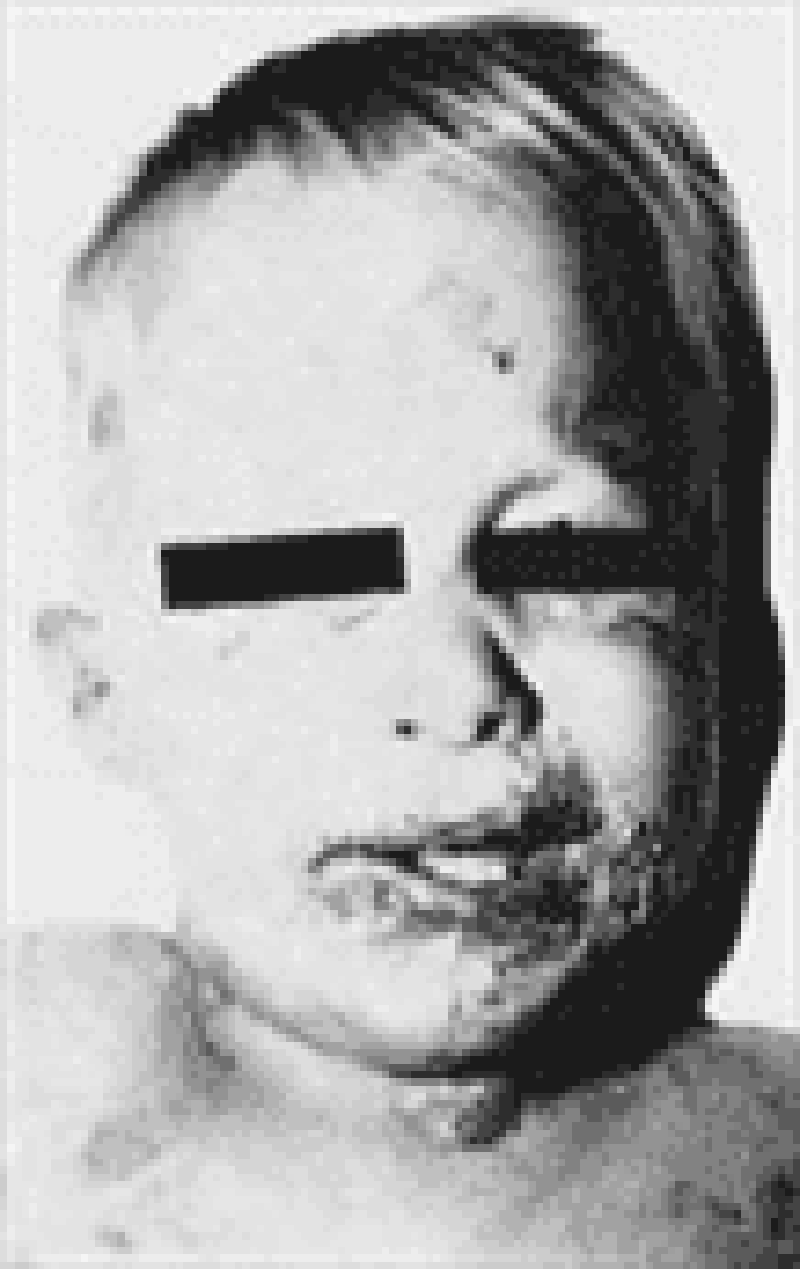
286) The rash and mucous membrane lesions shown in the photograph below develop in an infant 5 days into the course of an upper respiratory infection with otitis media; the child is being treated with amoxicillin. The child’s condition is likely which of the following?
. Urticaria
. Rubeola
. Stevens-Johnson syndrome
. Kawasaki disease
. Scarlet fever

298) A 7-year-old male is brought to the emergency department for a suspected femur fracture. He has had multiple fractures in the past after minor trauma. Today, his mother states that he was running and fell. He complained of pain in his thigh after he fell. His examination is remarkable for tenderness to palpation and slight deformity of his right proximal thigh. He has decreased muscle tone throughout. His eye examination is shown below. Which of the following is the most likely associated finding?
Aortic root dilatation
Horseshoe kidney
Opalescent teeth
Mental retardation
Ash leaf macules

312) The newborn nursery calls to notify you that a 1-day-old baby boy has developed abdominal distension and bilious emesis. Prenatal history was significant for areas of echogenic bowel seen on ultrasound. You order an abdominal radiograph; based on the results you order a contrast enema. Both are shown here. This infant is most likely to have which of the following?
. Duodenal atresia
. Cystic fibrosis
. Gastroenteritis
. Malrotation with volvulus
. Hirschsprung disease

315) At the time of delivery, a woman is noted to have a large volume of amniotic fluid. At 6 hours of age, her baby begins regurgitating small amounts of mucus and bile-stained fluid. Physical examination of the infant is normal, and an abdominal x-ray is obtained (see below). Which of the following is the most likely diagnosis of this infant’s disorder?
Gastric duplication
Pyloric stenosis
Esophageal atresia
Duodenal atresia
Midgut volvulus

319) The infant in the following picture presents with hepatosplenomegaly, anemia, persistent rhinitis, and a maculopapular rash. Which of the following is the most likely diagnosis for this child?
Toxoplasmosis
Glycogen storage disease
Congenital hypothyroidism
Congenital syphilis
Cytomegalovirus disease

334) You are seeing a 2-year-old boy for the first time. His father denies any past medical or surgical history, but does note that the child’s day care recently sent a note home asking about several episodes, usually after the child does not get what he wants, when he “breathes funny” and sits in a corner with his knees under his chin for a few minutes. The day-care staffers think this “self-imposed time-out” is a good thing, but they worry about the breathing. One teacher even though he once looked blue, but decided that it was probably because of the finger paints he had been using. On examination, you identify a right ventricular impulse, a systolic thrill along the left sternal border, and a harsh systolic murmur (loudest at the left sternal border but radiating through the lung fields). His chest radio- graph and ECG are shown. Which of the following congenital cardiac lesions would you expect to find in this child?
Patent ductus arteriosus
Right ventricular outflow obstruction
Atrial septal defect (ASD)
Transposition of the great vessels with a patent foramen ovale
Hypoplastic left heart

337) For the past year, a 12-year-old boy has had recurrent episodes of swelling of his hands and feet, which has been getting worse recently. These episodes occur following exercise and emotional stress, last for 2 to 3 days, and resolve spontaneously. The last episode was accompanied by abdominal pain, vomiting, and diarrhea. The results of routine laboratory workup are normal. An older sister and a maternal uncle have had similar episodes, but they were not given a diagnosis. He presents today with another episode as shown in the photographs on the next page. Which of the following is the most likely diagnosis?
Systemic lupus erythematosus
Focal glomerulosclerosis
Congenital nephrotic syndrome
Hereditary angioedema
Henoch-Schönlein purpura

348) Two weeks after a viral syndrome, a 9-year-old boy presents to your clinic with a complaint of several days of weakness of his mouth. In addition to the drooping of the left side of his mouth, you note that he is unable to completely shut his left eye. His smile is asymmetric, but his examination is otherwise normal. Which of the following is the most likely diagnosis?
Guillain-Barré syndrome
Botulism
Cerebral vascular accident
Brainstem tumor
Bell palsy

349) A 4-year-old girl is noticed by her grandmother to have a limp and a some-what swollen left knee. The parents report that the patient occasionally com- plains of pain in that knee. An ophthalmologic examination reveals findings as depicted in the photograph. Which of the following conditions is most likely to be associated with these findings?
Juvenile rheumatoid arthritis
Slipped capital femoral epiphysis
Henoch-Schönlein purpura
Legg-Calvé-Perthes disease
Osgood-Schlatter disease
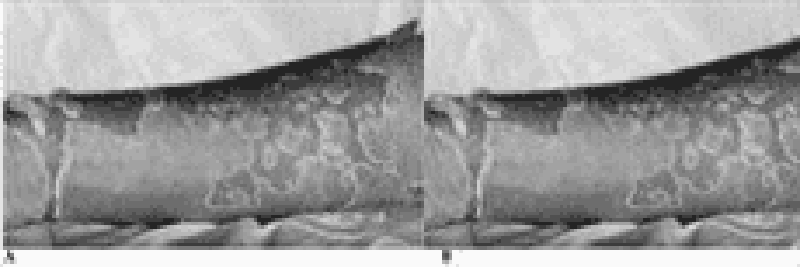
355) A previously healthy 4-year-old child pictured below presents to the emergency room (ER) with a 2-day history of a brightly erythematous rash and temperature of 40°C (104°F). The exquisitely tender, generalized rash is worse in the flexural and perioral areas. The child is admitted and over the next day develops crusting and fissuring around the eyes, mouth, and nose. The desquamation of skin shown in the photograph occurs with gentle traction. Which of the following is the most likely diagnosis?
Epidermolysis bullosa
Staphylococcal scalded skin syndrome
Erythema multiforme
Drug eruption
Scarlet fever

368) The child shown below presents with a 3-day history of malaise, fever to 41.1C (106F), cough, coryza, and conjunctivitis. He then develops the erythematous, maculopapular rash pictured. He is noted to have white pinpoint lesions on a bright red buccal mucosa in the area opposite his lower molars. Which of the following is the most likely diagnosis?
. Parvovirus
. Rubella
. Herpes
. Rubeola
. Varicella
{"name":"Part III picture", "url":"https://www.quiz-maker.com/QPREVIEW","txt":"106) A 12-year-old boy notices a scaly, mildly pruritic rash on his arm (see image below). There is no associated fever, muscle pain, nausea, vomiting, diarrhea, or back pain. He recently started taking swimming classes. The rash is most likely to clear with which of the following therapies?, 3) A 25-year-old male presents with skin lesions over his elbows, knees and neck. He complains of intense itching and burning sensation over these lesions for the past 10 days. He was advised to follow a gluten-free diet on his previous visit, but was not compliant. His vital signs are stable. On examination, there are flesh-colored to erythematous vesicles distributed over the extensor aspects of elbows, knees, posterior neck and shoulders. Some of these lesions are shown in the picture below. Which of the following is the drug of choice for his skin condition?, 5) A 22-year-old male presents with a 6-month history of a red, nonpruritic rash over the trunk, scalp, elbows, and knees. These eruptions are more likely to occur during stressful periods and have occurred at sites of skin injury. The patient has tried topical hydrocortisone without benefit. On examination, sharply demarcated plaques are seen with a thick scale. Pitting of the fingernails is present. There is no evidence of synovitis. What is the best first step in the therapy of this patient’s skin disease?","img":"https://cdn.poll-maker.com/12-557654/28.png?sz=1200"}
More Quizzes
Calmar251 new
630
Who is quiz
10510
ASSESSMENT - SEARLE NEUROSCIENCES: TULIP A
16820
Lending Ops Quiz
211040
Ace Your Country Map Test: Free World Map Challenge
201030664
Free Forex Trading Knowledge Test
201031409
Think You Know Every Dish? Take Our Foods of the World
201084461
Are You a WoW Expert? Take This World of Warcraft
201023973
Can You Ace Our Ultimate Cell Structure?
201031031
Take the Epic: Are You Truly Epic? Find Out Now!
201033036
Which Lollipop Flavor Are You? Free Personality
201027773
Tuberculosis Test: Master the Mantoux Skin Test
201025240